1
All of the following statements accurately
characterize the relief sculpture shown
below, EXCEPT:
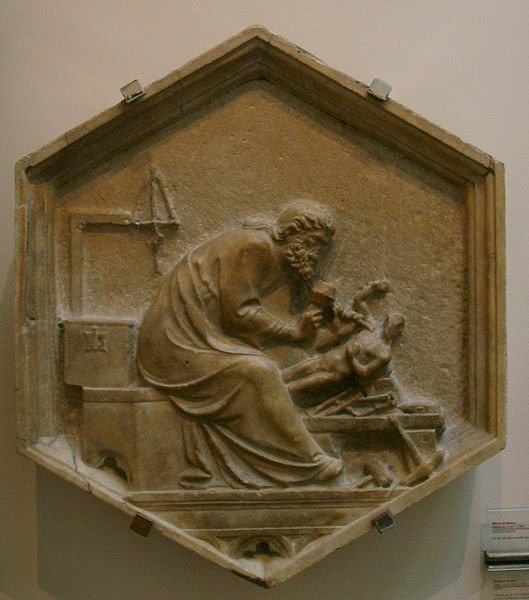
Choose one answer.
|
a.
It was carved by Donatello.
|
||
|
b.
It was made in the first half
of the fourteenth century.
|
||
|
c.
It represents the industry of
sculpture. |
||
|
d.
It can be considered an
expression of the willingness
to elevate the status of the
artist. |
||
|
e.
It was made for the bell tower
of the cathedral of Florence.
|
Question 2
All of the following statements accurately
describe the painting shown below,
EXCEPT:
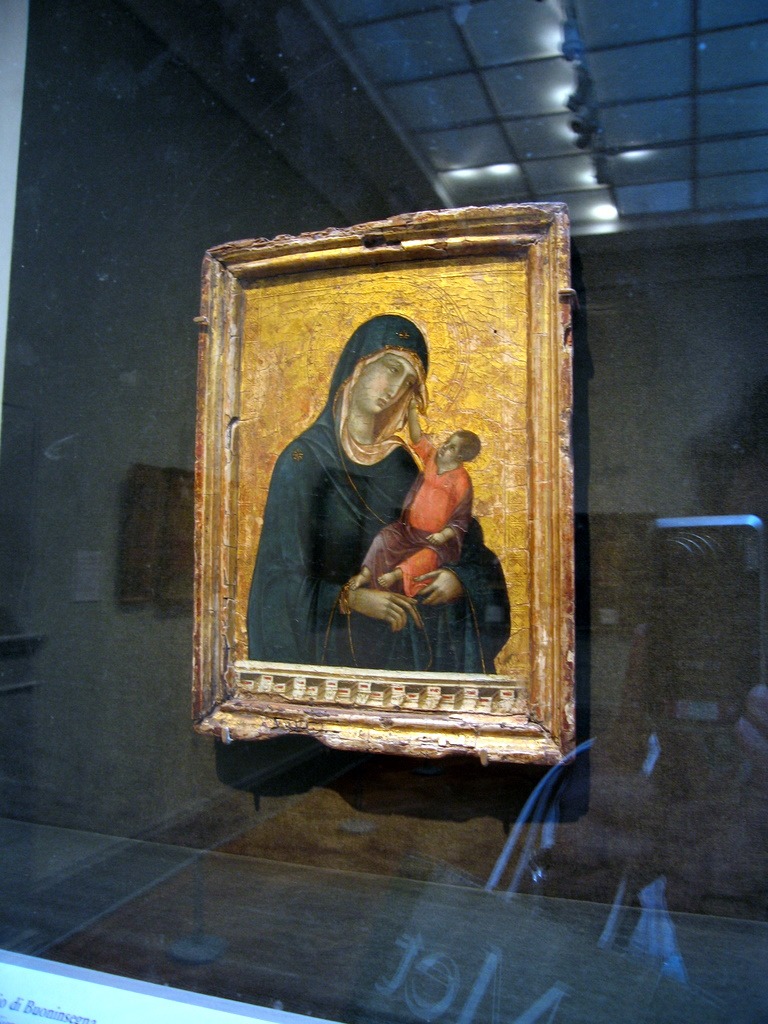
Choose one answer.
|
a.
It was made by Duccio during
the Proto-Renaissance.
|
||
|
b.
Compared with Byzantine art,
there is more of an emphasis on
human emotion and psychology.
|
||
|
c.
The parapet in front of the
figures is taken from
prototypes gleaned from
Byzantine icons. |
||
|
d.
Both A and B |
||
|
e.
Both B and C |
Question 3
All of the following statements accurately
describe the painting shown and its place
within art history, EXCEPT:
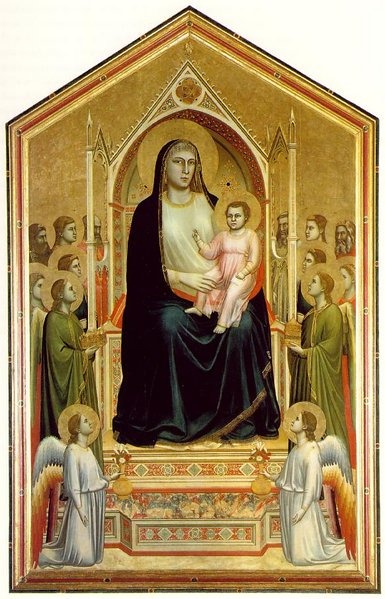
Choose one answer.
|
a.
It represents a “Madonna
Enthroned.” |
||
|
b.
It was painted by Giotto.
|
||
|
c.
It was innovative in its use of
a gold background. |
||
|
d.
The monumentality of the
painted figures was innovative
at the time of the painting’s
creation. |
||
|
e.
It was innovative in its use of
overlapping figures to suggest
three-dimensional space.
|
Question 4
All of the following statements accurately
describe the structure shown below,
EXCEPT:
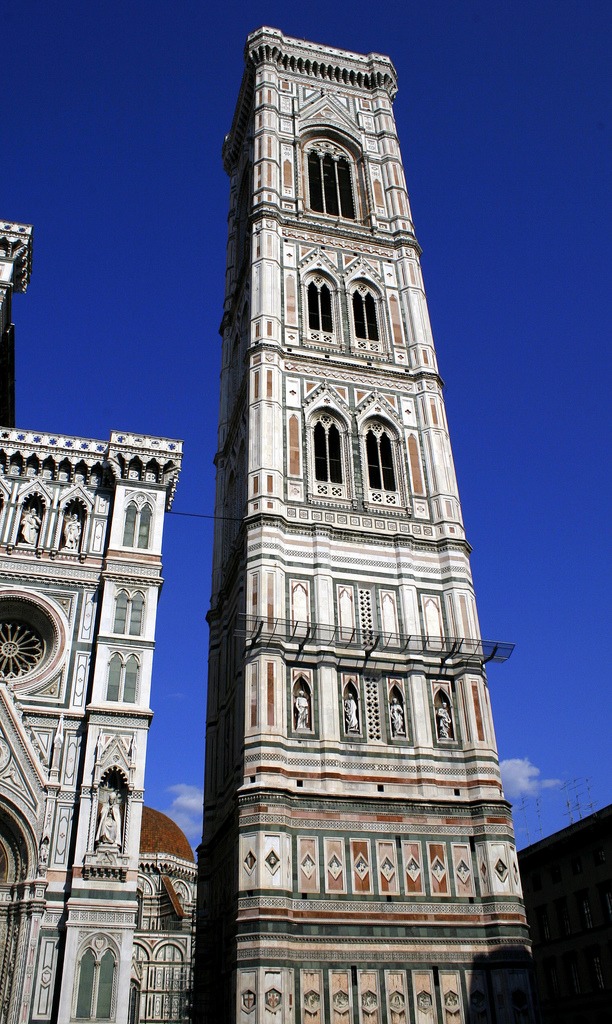
Choose one answer.
|
a.
It is a baptistery.
|
||
|
b.
It is a bell tower or
“campanile.” |
||
|
c.
It was decorated with reliefs
by Pisano. |
||
|
d.
It is in Florence. |
||
|
e.
All of the above |
Question 5
For Bernard Smith, which of the following
artists best represents the first full
expression of the innovations of
“Trencento” art?
Choose one answer.
|
a.
Cimabue and Giotto |
||
|
b.
Giotto and Duccio |
||
|
c.
Giotto and Masaccio
|
||
|
d.
Masaccio and Donatello
|
||
|
e.
Giotto and Gentile da Fabriano
|
Question 6
How was the Byzantine influence manifested
in certain paintings of the
Proto-Renaissance in Italy?
Choose one answer.
|
a.
The modeling of figures and
clothes with white highlights
in some paintings can be seen
as taken from Byzantine
prototypes. |
||
|
b.
The representation of folds of
cloth rendered through the use
of a series of very fine gold
lines and the flat gold
backgrounds of some paintings
can be seen as taken from
Byzantine prototypes.
|
||
|
c.
The plasticity and
monumentality of the figures in
some paintings can be seen as
taken from Byzantine
prototypes. |
||
|
d.
Both A and B |
||
|
e.
Both B and C |
Question 7
In which city-state was this structure
built during the fourteenth century?
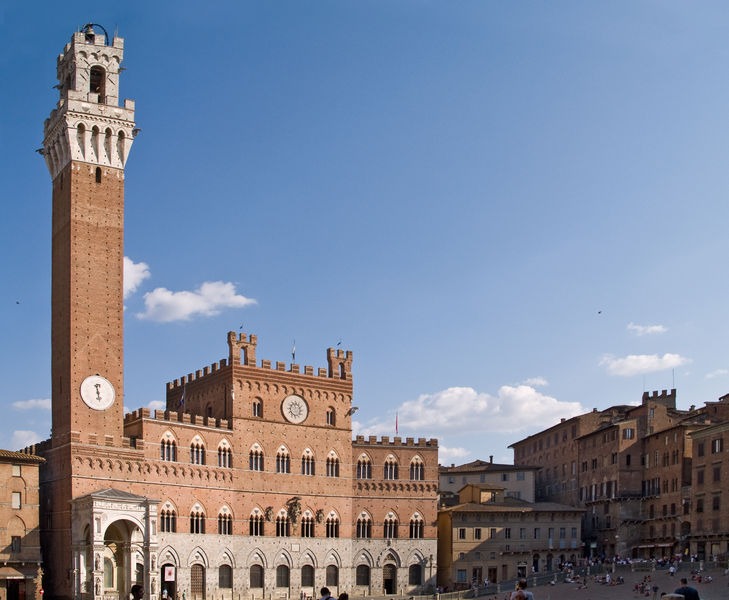
Choose one answer.
|
a.
Siena |
||
|
b.
Mantua |
||
|
c.
Florence |
||
|
d.
Milan |
||
|
e.
None of the above |
Question 8
What Byzantine elements are visible in this
painting by Berlinghiero?
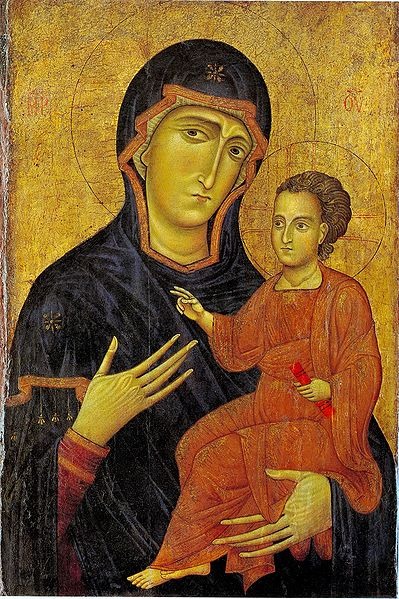
Choose one answer.
|
a.
The iconography of the Madonna
pointing to the child as a way
to salvation, or the “Madonna
Hodegetria” |
||
|
b.
The starburst-like motifs on
the Madonna’s head and shoulder
|
||
|
c.
The flatness of the Madonna’s
hands |
||
|
d.
The gold background
|
||
|
e.
All of the above |
Question 9
Which of the following accurately describes
the mendicant orders’ impact on art in the
late Middle Ages and early Renaissance?
Choose one answer.
|
a.
Saint Francis became a common
figure in the art of that era.
|
||
|
b.
The travelling friars
contributed to the Byzantine
influence in devotional images.
|
||
|
c.
The representation of Christ’s
physical suffering was avoided
in the art of that era.
|
||
|
d.
Both A and B |
||
|
e.
Both B and C |
Question 10
Which of the following artists is the best
representative of the “International Gothic
Style” in Italy?
Choose one answer.
|
a.
Gentile da Fabriano
|
||
|
b.
Duccio |
||
|
c.
Ambrogio Lorenzetti
|
||
|
d.
Cimabue |
||
|
e.
Pierro della Francesca
|
Question 11
Which of the following statements about the
process of panel painting in the
Proto-Renaissance is true?
Choose one answer.
|
a.
The support was made with wood
planks. |
||
|
b.
Often, a piece of linen soaked
with glue was applied over the
panel. |
||
|
c.
An application of gesso served
as a ground for the first
drawings. |
||
|
d.
Before painting, the panel was
often gilded with gold leaf.
|
||
|
e.
All of the above |
Question 12
Which of the following statements
accurately characterizes the cycle of
frescos in the Upper Church of San
Francesco at Assisi?
Choose one answer.
|
a.
It depicts different episodes
of the legend of Saint Francis.
|
||
|
b.
The backgrounds to the scenes
are devoid of architectural or
natural elements. |
||
|
c.
It was painted by Masaccio.
|
||
|
d.
Both A and B |
||
|
e.
Both B and C |
Question 13
Which of the following statements
accurately describes the era of the Italian
Renaissance?
Choose one answer.
|
a.
During the era of the Italian
Renaissance, Italy was made up
of independent city-states.
|
||
|
b.
The Italian Renaissance was
characterized by a new focus on
the individual and his/her
perfectibility. |
||
|
c.
The Italian Renaissance mostly
affected rural areas.
|
||
|
d.
Both A and B |
||
|
e.
Both B and C |
Question 14
Which of the following statements
accurately describes the Church in the Late
Middle Ages in Italy and Europe?
Choose one answer.
|
a.
The mendicant friars became
important spiritual figures.
|
||
|
b.
There was a new focus on a more
personal relationship with God.
|
||
|
c.
The Papacy lost some of its
spiritual dominance.
|
||
|
d.
All of the above |
||
|
e.
None of the above |
Question 15
Which of the following statements
accurately describes the innovations of
“Trencento” art, according to Bernard
Smith?
Choose one answer.
|
a.
They were mostly based on
Byzantine prototypes.
|
||
|
b.
They included a move toward
greater naturalism, tactile
value, plasticity, and volume
within the representation of
figures or things. |
||
|
c.
They were encouraged in part by
the willingness to produce
narrative art. |
||
|
d.
Both A and B |
||
|
e.
Both B and C |
Question 16
Which of the following statements
accurately describes the “International
Gothic style”?
Choose one answer.
|
a.
Paintings in the “International
Gothic style” tend not to
display much surface detail in
the representation of
landscapes or costumes.
|
||
|
b.
Paintings in the “International
Gothic style” tend to create an
illusionistic deep space.
|
||
|
c.
Paintings in the “International
Gothic style” tend to show
elegant, rather than
sculptural, figures.
|
||
|
d.
Both A and B |
||
|
e.
Both B and C |
Question 17
Which of the following statements
accurately describes Florence during the
Proto Renaissance?
Choose one answer.
|
a.
During the thirteenth century,
church building by the
mendicants had a great impact
on the city-scape of Florence.
|
||
|
b.
Florence was the site of great
demographic and economic
expansion in the thirteenth
century. |
||
|
c.
During the fourteenth century,
a period of peace led to an
accelerated pace in building.
|
||
|
d.
Both A and B |
||
|
e.
Both B and C |
Question 18
Which of the following statements
accurately describes the fresco
below?
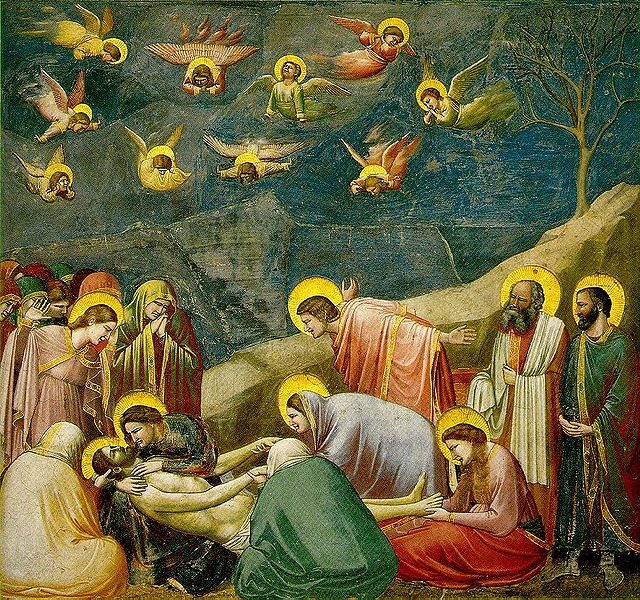
Choose one answer.
|
a.
It was painted in the Arena
Chapel in Padua in the early
fourteenth century.
|
||
|
b.
It represents the “Lamentation”
of Mary. |
||
|
c.
It is part of a larger cycle of
frescos depicting the life of
Christ and the life of Mary.
|
||
|
d.
It was painted by Giotto.
|
||
|
e.
All of the above |
Question 19
Which of the following statements
accurately describes early Renaissance
humanism?
Choose one answer.
|
a.
Humanists differentiated
themselves from certain
monastic texts on the lowly and
miserable nature of earthly
life by emphasizing the beauty
and order of nature and man.
|
||
|
b.
Humanists valued civic
involvement. |
||
|
c.
Humanists rediscovered ancient
classical texts. |
||
|
d.
All of the above |
||
|
e.
None of the above |
Question 20
Which of the following statements correctly
describes the structure below?
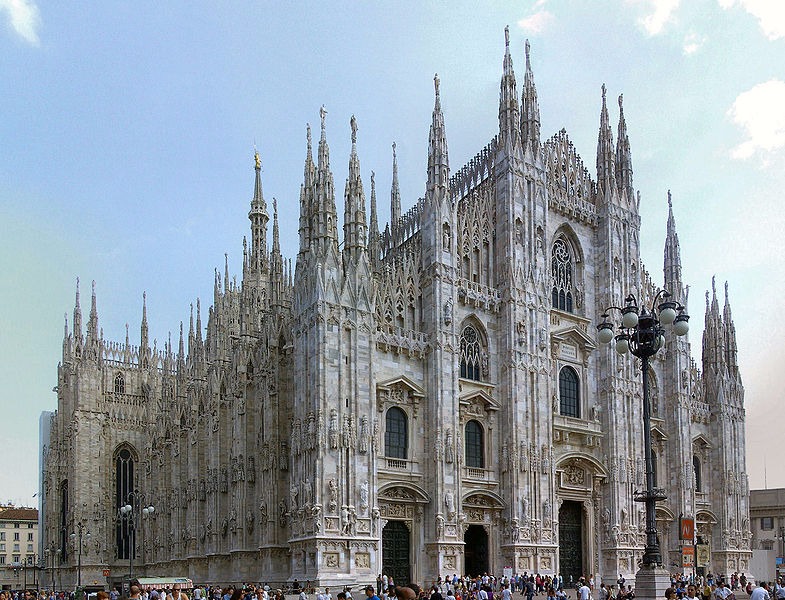
Choose one answer.
|
a.
It is an example of late Gothic
architecture in Italy.
|
||
|
b.
It is located in Florence.
|
||
|
c.
It typifies Italian cathedral
architecture of the fourteenth
and fifteenth centuries.
|
||
|
d.
All of the above |
||
|
e.
None of the above |
Question 21
Which of the following statements does NOT
accurately describe Sienese painting of the
Proto-Renaissance?
Choose one answer.
|
a.
It was much influenced by the
style of Duccio. |
||
|
b.
Overall, it tended to be more
realistic in style than
Florentine painting.
|
||
|
c.
The most characteristic
representative of the
“International Gothic style” in
Siena was Simone Martini.
|
||
|
d.
The artists who most
characteristically incorporated
innovations in the treatment of
space in Siena were the
Lorenzetti brothers.
|
||
|
e.
All of the above |
Question 22
Which of the following statements does NOT
describe the mendicant orders?
Choose one answer.
|
a.
The Franciscans and Dominicans
were important mendicant
orders. |
||
|
b.
They vowed to poverty.
|
||
|
c.
To survive, they depended upon
their listeners or followers.
|
||
|
d.
They stayed in seclusion from
society. |
||
|
e.
Some orders tried to imitate
Christ and draw attention to
his physical suffering.
|
Question 23
Which of the following statements is true
of the painting shown?

Choose one answer.
|
a.
It was painted by Cimabue.
|
||
|
b.
It represents the death of St.
Francis. |
||
|
c.
It was innovative in its
treatment of space, because it
made use of a normal eye-level
in its lower portion.
|
||
|
d.
It was one of the first oil on
canvas paintings. |
||
|
e.
None of the above |
Question 24
Which political units became the largest
and most important in Italy over the course
of the fourteenth and fifteenth centuries?
Choose one answer.
|
a.
The city-states of Rome and
Florence, and the kingdom of
Sicily |
||
|
b.
The city-states of Florence,
Venice, and Milan; the kingdoms
of Naples and Sicily; and the
Papal States |
||
|
c.
The city-states of Padua,
Genoa, and Florence, and the
Papal States |
||
|
d.
The city-states of Rome and
Mantua, and the kingdom of
Naples |
||
|
e.
None of the above |
Question 25
Which of the following statements
accurately characterizes thirteenth and
fourteenth-century Italian society?
Choose one answer.
|
a.
In the thirteenth century,
Florence was the center of a
small empire. |
||
|
b.
For most of the fourteenth
century, there was a pope in
Avignon, France, as well as in
Rome. |
||
|
c.
The Black Death killed tens of
thousands of people in the
fourteenth century.
|
||
|
d.
Both A and B |
||
|
e.
Both B and C |
Question 26
According to Elizabeth Lev, what are some
of the specific ways in which art
production and the use of classical
prototypes to create Christian art were
justified by actors of early Christianity
and the Renaissance?
Choose one answer.
|
a.
From the beginning, in the
fourth and fifth centuries, the
justification of Christian art
had been to make manifest, show
that God had been made man
(through Jesus Christ), using
Classical prototypes compatible
with Christian ideals, such as
the “Good Shepherd,” or the
face of Apollo that could
signify divinity. |
||
|
b.
Although Brunelleschi studied
the work and engineering of
ancient architects to design a
dome for the Cathedral of
Florence, he repurposed them in
a dome that was not Roman in
form and that served the
function of celebrating Mary.
|
||
|
c.
Although Donatello studied
ancient nude statuary to create
figures that had corporeality,
he never sculpted a nude
figure. |
||
|
d.
Both A and B |
||
|
e.
Both B and C |
Question 27
All of the following accurately
characterize the sculpture shown below,
EXCEPT:
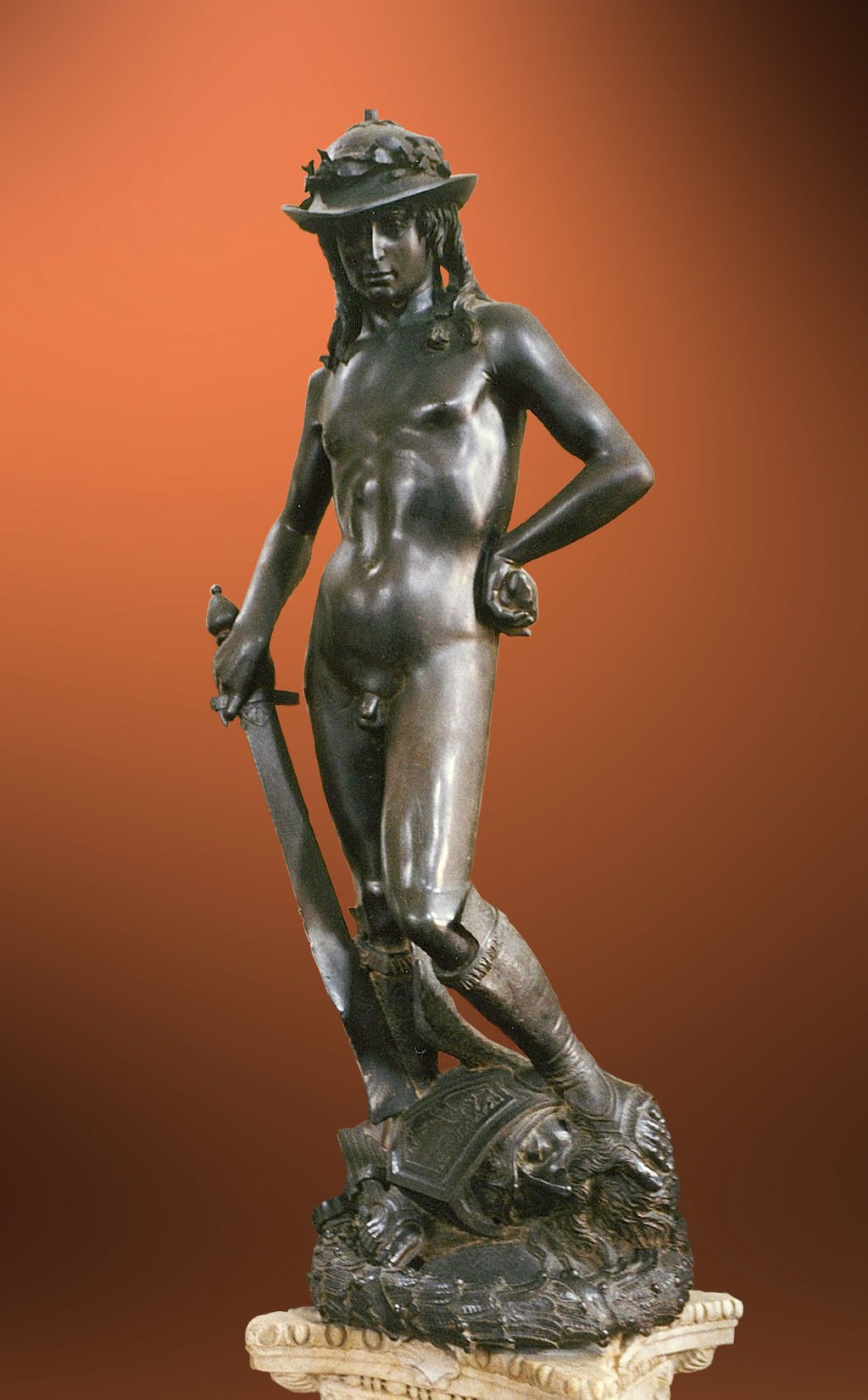
Choose one answer.
|
a.
It was made by Donatello.
|
||
|
b.
It represents David, victorious
over Goliath. |
||
|
c.
It was conceived for a niche of
the Cathedral of Florence.
|
||
|
d.
It was the first free-standing
nude sculpted figure since
classical antiquity.
|
||
|
e.
The figure is depicted in a
“contrapposto” position.
|
Question 28
All of the following statements accurately
describe the painting shown below,
EXCEPT:
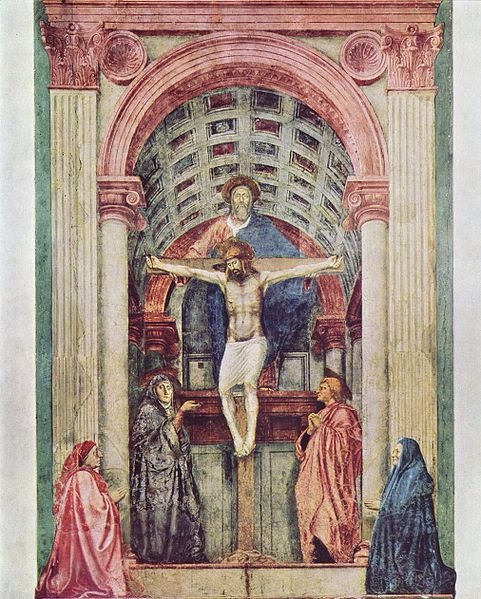
Choose one answer.
|
a.
It is a fresco by Masaccio.
|
||
|
b.
It depicts the “Holy Trinity.”
|
||
|
c.
It incorporates figures of
contemporary donors.
|
||
|
d.
It displays the use of aerial
perspective. |
||
|
e.
It incorporates certain
elements taken from the
material culture of Roman
antiquity. |
Question 29
All of the following statements accurately
describe the artist Antonello da Messina,
EXCEPT:
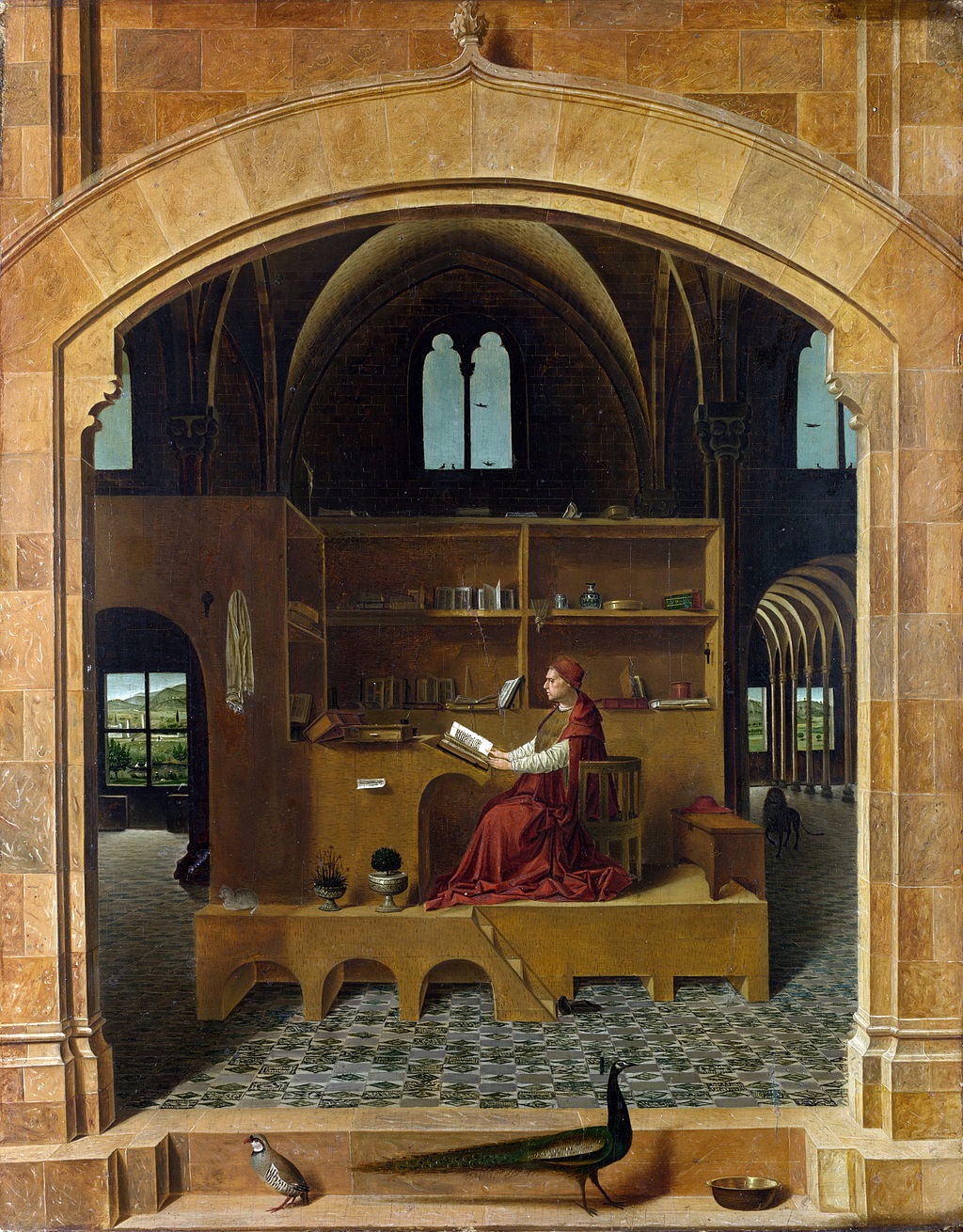
Choose one answer.
|
a.
He was influenced by Flemish
and Netherlandish artists.
|
||
|
b.
He was a Venetian painter.
|
||
|
c.
He painted the “Saint Jerome in
His Study” above. |
||
|
d.
Structure, geometry, light, and
tone as visual elements of art,
can be said to have been
particularly mastered in the
later work of this artist.
|
||
|
e.
In his later works, the
backgrounds to his scenes were
generally devoid of details.
|
Question 30
What are some ways by which artists of the
“Quattrocento” incorporated their
rediscovery of classical antiquity into
their artwork?
Choose one answer.
|
a.
Painters sometimes placed their
painted narratives in
architectural settings
displaying ancient classical
features, such as rounded
arches. |
||
|
b.
Painters sometimes incorporated
classical motifs gleaned from
Roman sculptures or cameos into
their artworks. |
||
|
c.
The nude free-standing
sculpture made its reappearance
in “Quattrocento” Italy.
|
||
|
d.
Artists developed ways to
better represent
three-dimensional space on a
two-dimensional surface.
|
||
|
e.
All of the above |
Question 31
Which fifteenth-century painter is usually
considered to have been the first to use
true linear perspective to create an
illusionistic space on a two-dimensional
surface?
Choose one answer.
|
a.
Giotto |
||
|
b.
Masaccio |
||
|
c.
Leonardo da Vinci |
||
|
d.
Fra Filippo Lippi |
||
|
e.
Sandro Boticelli |
Question 32
Which of the following does NOT accurately
describe the 1401 competition to decorate
the Florence Baptistery doors and Ghiberti
and Brunelleschi's submissions to this
competition?
Choose one answer.
|
a.
In the competition guidelines,
it was stated that the artist
needed to show knowledge of
Antiquity. |
||
|
b.
The subject-matter of Ghiberti
and Brunelleschi’s submissions
was “The Sacrifice of Isaac.”
|
||
|
c.
They both used classical Roman
prototypes to represent the
nude body or torso.
|
||
|
d.
The winning Ghiberti relief was
the one that departed most from
the elegant lines of the Gothic
tradition. |
||
|
e.
The winning Ghiberti relief was
cast from one single piece of
bronze and was much lighter
than Brunelleschi's.
|
Question 33
Which of the following figures was the
first to develop linear perspective?
Choose one answer.
|
a.
Andrea Mantegna |
||
|
b.
Giotto |
||
|
c.
Filippo Brunelleschi
|
||
|
d.
Lorenzo Ghiberti |
||
|
e.
Fra Angelico |
Question 34
Which of the following statements about
Alberti and his work is false?
Choose one answer.
|
a.
He was an architect and art
theorist. |
||
|
b.
He incorporated Roman temple
and triumphal arch motifs into
the design of Sant’ Andrea in
Mantua. |
||
|
c.
His façade of Basilica of Santa
Maria Novella in Florence is
treated as a reflection of the
interior space it encloses.
|
||
|
d.
All of the above |
||
|
e.
None of the above |
Question 35
Which of the following statements about
early Renaissance painting in Venice is
false?
Choose one answer.
|
a.
In a general sense and compared
to painting in other regions,
it is distinguished by its
colors and rendition of light.
|
||
|
b.
Because of its links to the
east, compared to Florentine
painting, Venetian painting
held on to its Byzantine
heritage longer. |
||
|
c.
Through links with Northern
Europe, Venetian painters were
introduced to oil painting.
|
||
|
d.
Giovanni Bellini was an
important Venetian painter in
the later fifteenth century.
|
||
|
e.
Sandro Boticelli was an
important Venetian painter in
the later fifteenth century.
|
Question 36
Which of the following statements about
Nanni di Banco’s “Four Crowned Martyrs” is
true?
Choose one answer.
|
a.
It was created for the stone
and wood worker’s guild’s niche
at Orsanmichele, in Florence.
|
||
|
b.
It represents sculptors who
became Christian martyrs for
refusing to sculpt a Roman
deity. |
||
|
c.
The sculpted figures seem
weightless, as if to signify
their spiritual nature, and
they hold the symbol of
martyrdom: a palm leaf.
|
||
|
d.
A and B |
||
|
e.
B and C |
Question 37
Which of the following statements about
Sienese painting in the 1400s is false?
Choose one answer.
|
a.
Compared to Florentine
painting, it was more medieval
in style. |
||
|
b.
It was influenced by the
innovations taking place in
Florence. |
||
|
c.
The influence of Duccio and
Simone Martini can be
identified in the 1400s.
|
||
|
d.
Many images were made of the
Virgin, because she was Siena’s
patron saint. |
||
|
e.
Fra Angelico is an important
representative of
fifteenth-century Sienese art.
|
Question 38
Which of the following statements
accurately describes the influence of the
papacy during the fifteenth and early
sixteenth centuries?
Choose one answer.
|
a.
Popes were increasingly seen as
the promoters of humility and
renunciation of “worldly”
pursuits. |
||
|
b.
Popes sometimes took part in
“worldly” matters and collected
ancient art. |
||
|
c.
During the fifteenth century,
Rome again became the seat of
the papacy. |
||
|
d.
Both A and B |
||
|
e.
Both B and C |
Question 39
Which of the following statements
accurately describes linear perspective?
Choose one answer.
|
a.
When it is used in painting, it
depicts space as seen from
multiple points of view.
|
||
|
b.
In linear perspective,
orthogonals merge at a
vanishing point. |
||
|
c.
In linear perspective, the
vanishing point is on the
horizon line. |
||
|
d.
Both A and B |
||
|
e.
Both B and C |
Question 40
Which of the following statements
accurately describes the structure
below?
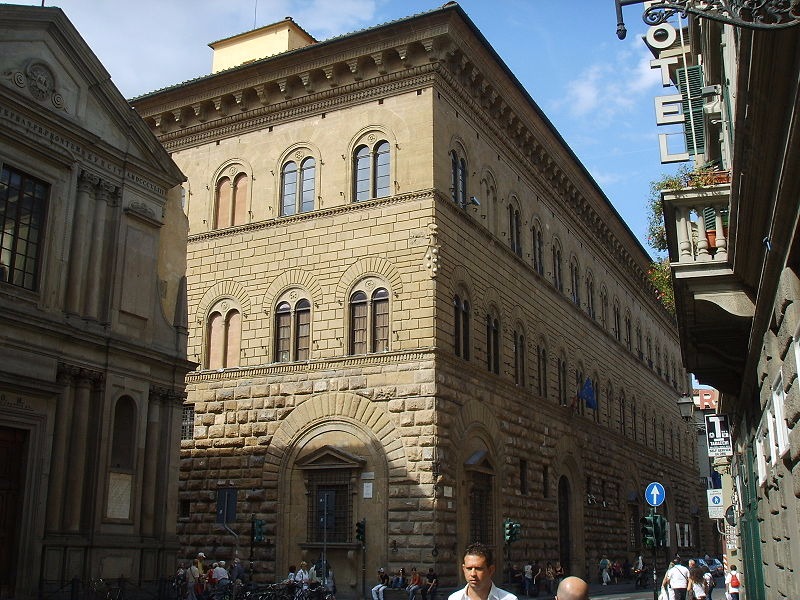
Choose one answer.
|
a.
It was built for Cosimo Medici
(Cosimo Vecchio) by Michelozzo.
|
||
|
b.
It was partly defensive in
nature. |
||
|
c.
It had a rusticated first
story, imposing cornice, and
interior court. |
||
|
d.
Its private spaces displayed
more wealth than its public
ones. |
||
|
e.
All of the above |
Question 41
Which of the following statements
accurately describes Fra Angelico’s
contribution to the history of art?
Choose one answer.
|
a.
He represents the full
expression of the
“International Gothic style.”
|
||
|
b.
He is known as the first
painter to effectively use
linear perspective to create an
illusionistic space on a
two-dimensional surface.
|
||
|
c.
He was one of the early
Renaissance innovators for
treatment of space as well as
for the arrangement and
modeling of figures.
|
||
|
d.
Both A and B |
||
|
e.
Both B and C |
Question 42
Which of the following statements
accurately describes the painting
below?
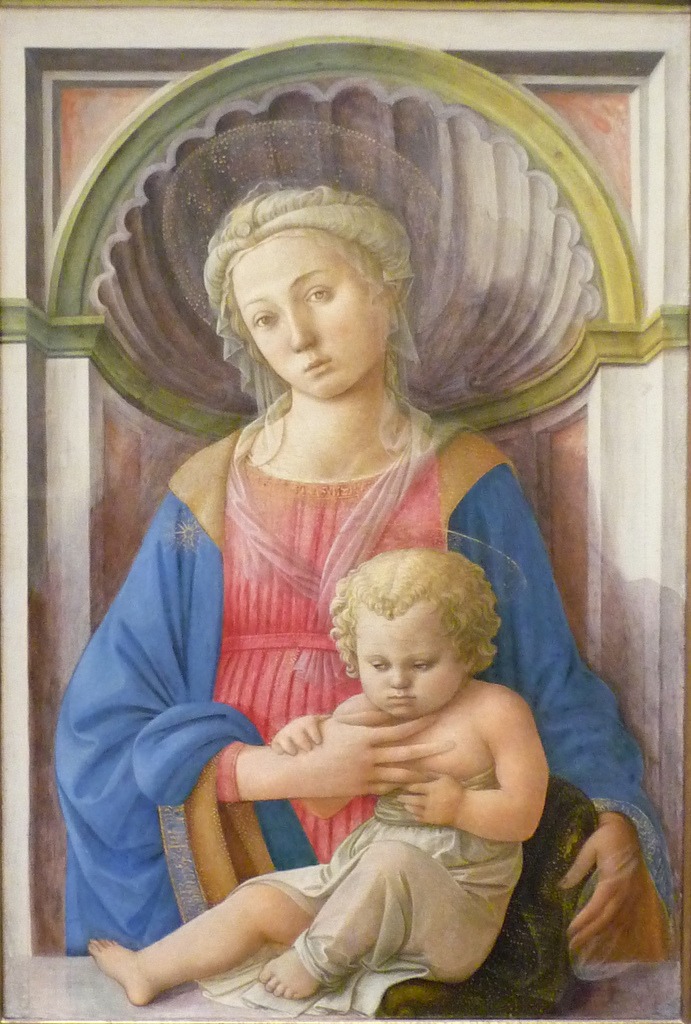
Choose one answer.
|
a.
The general “softness” of the
image, for example the soft,
delicate and curvilinear lines
of the Madonna’s veil, show
Masaccio’s influence on the
artist. |
||
|
b.
It was painted by Fra Fillipo
Lippi in the mid-fifteenth
century. |
||
|
c.
Compared to medieval examples,
the painting displays more
willingness to reproduce
elements of the visible world
faithfully. |
||
|
d.
Both A and B |
||
|
e.
Both B and C |
Question 43
Which of the following statements best
describes the painting below?
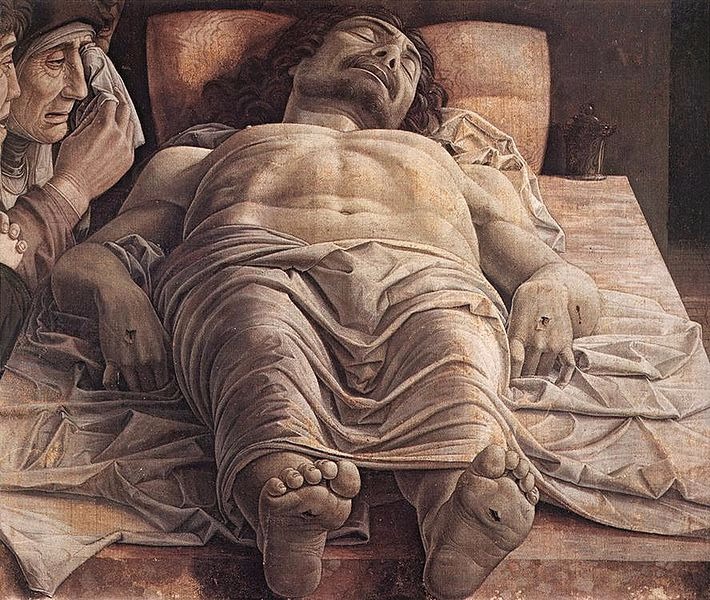
Choose one answer.
|
a.
It was painted by Bellini.
|
||
|
b.
It represents a “Dead Christ.”
|
||
|
c.
It makes use of exact
mathematical linear perspective
to for-shorten the represented
body. |
||
|
d.
Both A and B |
||
|
e.
Both B and C |
Question 44
Which of the following statements correctly
describes Platonism or Renaissance
Platonism?
Choose one answer.
|
a.
It is founded on the figure of
Plato, whose fundamental
philosophy rested on the
perceived superiority of
empirical knowledge.
|
||
|
b.
It is founded on the figure of
Plato, who believed that true
knowledge was to be gleaned
from a world of eternal forms
rather than from the visible
world. |
||
|
c.
It developed into a widely
taught and disseminated study
program during the fifteenth
century. |
||
|
d.
Both A and B |
||
|
e.
Both B and C |
Question 45
Which of the following statements does NOT
accurately describe the dome of the
Cathedral of Florence and its construction?
Choose one answer.
|
a.
It was designed by Alberti.
|
||
|
b.
It was larger than any dome
that had been constructed
previously. |
||
|
c.
Its construction began in the
early fifteenth century.
|
||
|
d.
It has a herringbone pattern.
|
||
|
e.
It is not a completely rounded
dome. |
Question 46
Which of the following statements does NOT
accurately describe Florence in the Early
Renaissance?
Choose one answer.
|
a.
All segments of society could
participate in government.
|
||
|
b.
Florence was a republic in
which the nobility had limited
power. |
||
|
c.
During the early fifteenth
century, Florence accumulated a
few victories against the
military of other Italian kings
and dukes. |
||
|
d.
Florentines tended to see their
city as a new, Christian, Rome.
|
||
|
e.
Florence became the cradle of
the artistic Renaissance.
|
Question 47
Which of the following statements fairly
characterizes Andrea Mantegna and his art?
Choose one answer.
|
a.
According to Keith
Christiansen, he achieved
extraordinary status as an
artist, and thus helped change
the way by which artistic
genius was measured during the
Renaissance as well as change
the status of the artist
itself. |
||
|
b.
He painted a ceiling fresco,
“Camera degli Sposi,” that
shows an elaborate
illusionistic architecture.
|
||
|
c.
He painted a “Saint Sebastian,”
now conserved in Vienna, in
which a martyr is taking place
in front of a church.
|
||
|
d.
Both A and B |
||
|
e.
Both B and C |
Question 48
Which of the following statements fairly
describes the painting below?
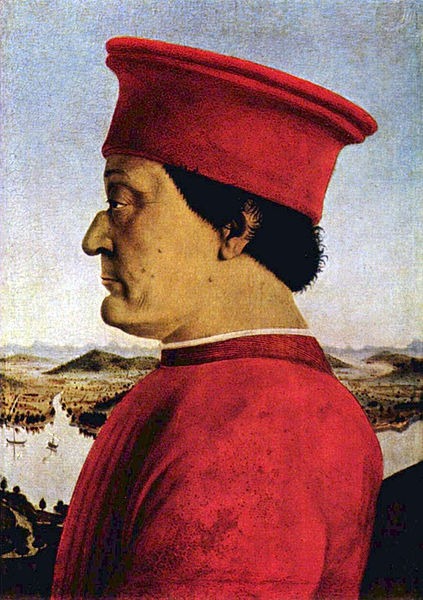
Choose one answer.
|
a.
It represents a member of the
Medici family painted by Fra
Fillipo Lippi. |
||
|
b.
It is a manifestation of the
reemergence of portrait art and
the emphasis on individuality
in the Renaissance.
|
||
|
c.
It is part of a double portrait
in which the portrait of the
figure’s wife is facing it.
|
||
|
d.
Both A and B |
||
|
e.
Both B and C |
Question 49
Which of the following statements is true
of Venetian architecture of the fifteenth
century?
Choose one answer.
|
a.
For most of the century,
Venetian architecture had a
distinctive style, in which
oriental, Veneto-Byzantine, and
Gothic influences cohabitated.
|
||
|
b.
Early on, Venetian architects
tried to rival the “innovative
reemergence” of the classical
tradition in the architecture
of Florence and build classical
structures. |
||
|
c.
There was a strong Gothic
influence but only in church
construction. |
||
|
d.
Though the Venetians were
inspired by the architectural
Renaissance taking place in
Florence, lack of prosperity in
the early fifteenth century
made the undertaking of large
construction projects dwindle.
|
||
|
e.
None of the above |
Question 50
Which of the following statements
accurately explains why it is argued that
the Renaissance began in the Italian
city-states? A. The Renaissance began in
Italy, because it was the location where
ancient Roman remains were.
Choose one answer.
|
a.
With their position in between
east and west, the Italian
city-states became the site of
trade, mercantilism, exchange
of knowledge, and the
development of a new wealthy
class that could pursue
knowledge and fund artistic
endeavors. |
||
|
b.
The Renaissance began in Italy,
because the printing press and
movable type were invented
there. |
||
|
c.
Both A and B |
||
|
d.
Both B and C |
Question 51
According to John Freed, why does
Michelangelo’s “David” embody the shift
from the medieval to the early modern world
when compared to Donatello’s “David”?
Choose one answer.
|
a.
Because of its greater
anatomical realism |
||
|
b.
Because Donatello’s “David” is
clothed, while Michelangelo’s
“David” is nude |
||
|
c.
Because Michelangelo’s “David”
speaks more of Michelangelo
than of “David” |
||
|
d.
All of the above |
||
|
e.
None of the above |
Question 52
All of the following are considered to be
characteristics or ideals of High
Renaissance art in Italy, EXCEPT:
Choose one answer.
|
a.
A focus on human psychology and
interrelations in painting.
|
||
|
b.
A new interest for irrational
space. |
||
|
c.
An interest for the “natural”
and naturalism. |
||
|
d.
Careful compositions based on
ideal geometric forms.
|
||
|
e.
An interest in human anatomy.
|
Question 53
All of the following statements accurately
describe the painting shown, EXCEPT:
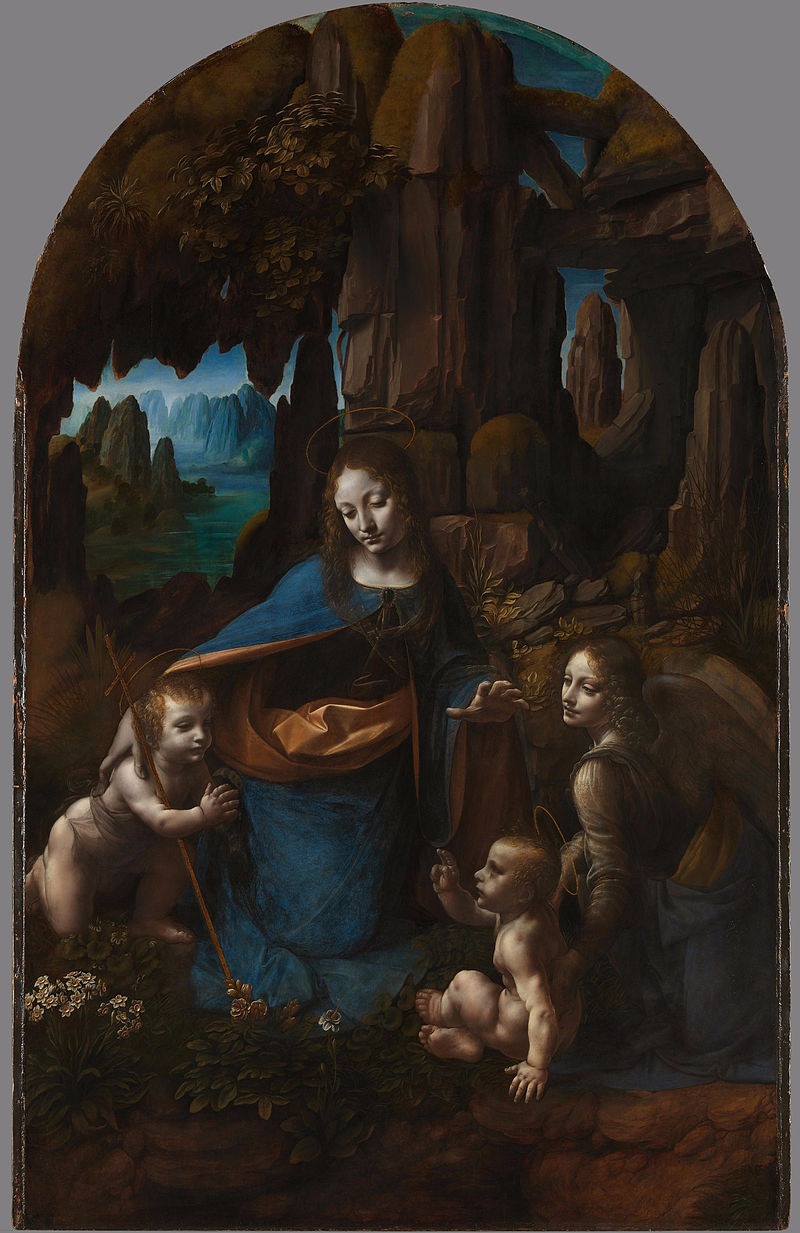
Choose one answer.
|
a.
It represents the Virgin Mary,
John the Baptist, Christ, and
an archangel. |
||
|
b.
It was painted by Leonardo da
Vinci during the High
Renaissance. |
||
|
c.
The garden and the water, as
well as being depicted in a way
that is very close to nature,
could symbolize the Virgin’s
purity. |
||
|
d.
The “sfumato” technique used
tends to soften the image.
|
||
|
e.
Although the background shows a
lot of detail, Leonardo did not
use atmospheric perspective.
|
Question 54
All of the following statements accurately
describe the painting shown below,
EXCEPT:

Choose one answer.
|
a.
It was painted by Bellini and
Titian. |
||
|
b.
It represents a “Feast of the
Gods” in which Priapus, the God
of virility, was humiliated
after trying to lift a nymph’s
skirt. |
||
|
c.
Priapus is the figure near the
center, wearing the green robe.
|
||
|
d.
Both A and B |
||
|
e.
Both B and C |
Question 55
All of the following statements correctly
describe Palladio, EXCEPT:
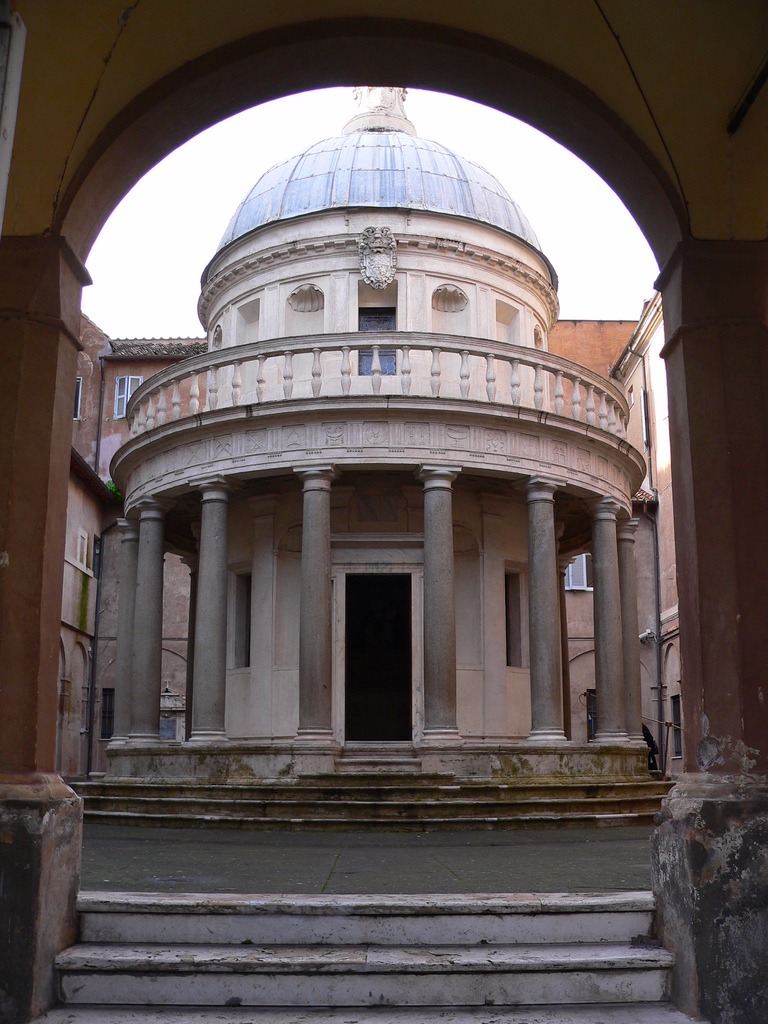
Choose one answer.
|
a.
He was the architect who
designed the “Tempietto,”
pictured above. |
||
|
b.
He wrote a treatise on
architecture that contained
practical advice for
architects. |
||
|
c.
He was a Venetian architect.
|
||
|
d.
He built villas that were
symmetric in plan. |
||
|
e.
He built churches that featured
temple front designs.
|
Question 56
In what way was Leonardo da Vinci’s “Mona
Lisa” innovative?
Choose one answer.
|
a.
It was innovative, because da
Vinci was more interested in
the perceived physical flaws of
the sitter than in her
perceived beauty. |
||
|
b.
It was innovative in that the
focus was less on the status of
the sitter and more on her
personality when compared to
portraits of the era.
|
||
|
c.
It was innovative, because in
the early Renaissance,
portraits were usually done in
profile, and the arms and hands
were usually cut off.
|
||
|
d.
Both A and B |
||
|
e.
Both B and C |
Question 57
In what ways can one distinguish the styles
of Michelangelo, Leonardo da Vinci, and
Raphael?
Choose one answer.
|
a.
Unlike da Vinci and Raphael,
Michelangelo, first and
foremost a sculptor, tended to
emphasize the musculature of
his figures, and more
generally, the linear and the
sculptural. |
||
|
b.
Raphael was influenced by the
style of Leonardo da Vinci; he
created very harmonious
compositions, but in general,
the colors he used were darker
than da Vinci’s, and he created
hazier, unclear atmospheres
than Leonardo da Vinci.
|
||
|
c.
Leonardo da Vinci created very
harmonious compositions based
on geometrical forms in which
figures interrelate with one
another, but compared to
Raphael and Michelangelo, he
used much lighter colors and
created images with clearer
outlines. |
||
|
d.
All of the above |
||
|
e.
None of the above |
Question 58
Which architect designed the structure
below?
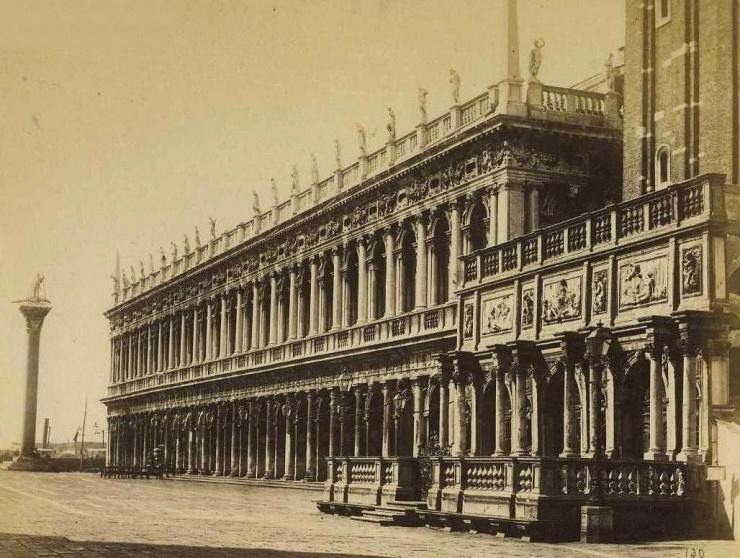
Choose one answer.
|
a.
Palladio |
||
|
b.
Alberti |
||
|
c.
Michelangelo |
||
|
d.
Sansovino |
||
|
e.
Bramante |
Question 59
Which of the following accurately
characterizes the “School of Athens”
painted by Raphael?
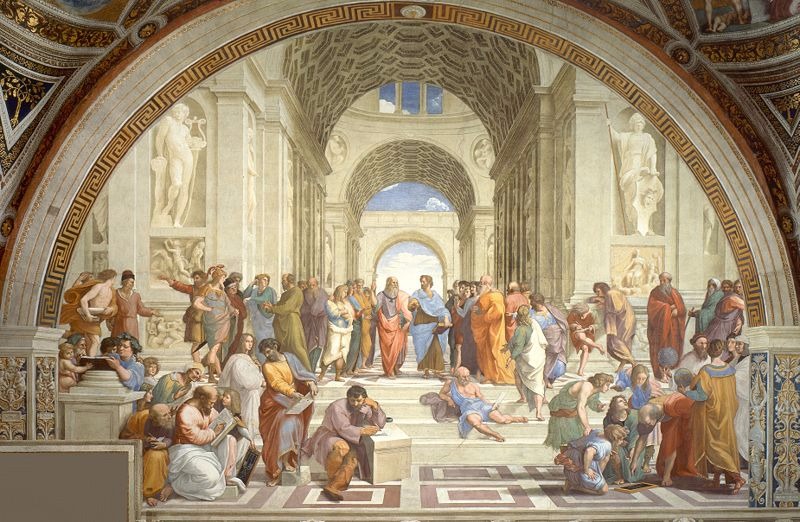
Choose one answer.
|
a.
It shows Leonardo da Vinci,
Michelangelo, and Bramante’s
traits, in the guise of ancient
artists of Greece. |
||
|
b.
According to Timothy Verdon,
because it was more important
in its original context than
the “Disputa del Sacramento,”
it was seen first when one
entered into the space
enclosing the two frescoes.
|
||
|
c.
According to Timothy Verdon,
“School of Athens” and the
“Disputa del Sacramento” both
show figures moving toward the
viewer of the artworks.
|
||
|
d.
It symbolically placed the
viewer entering the space
enclosing it and the “Disputa
del Sacramento” in a grand
procession, taking its roots in
classical Antiquity and moving
toward the kingdom of God.
|
||
|
e.
All of the above |
Question 60
Which of the following statements about the
painter Giorgione is false?
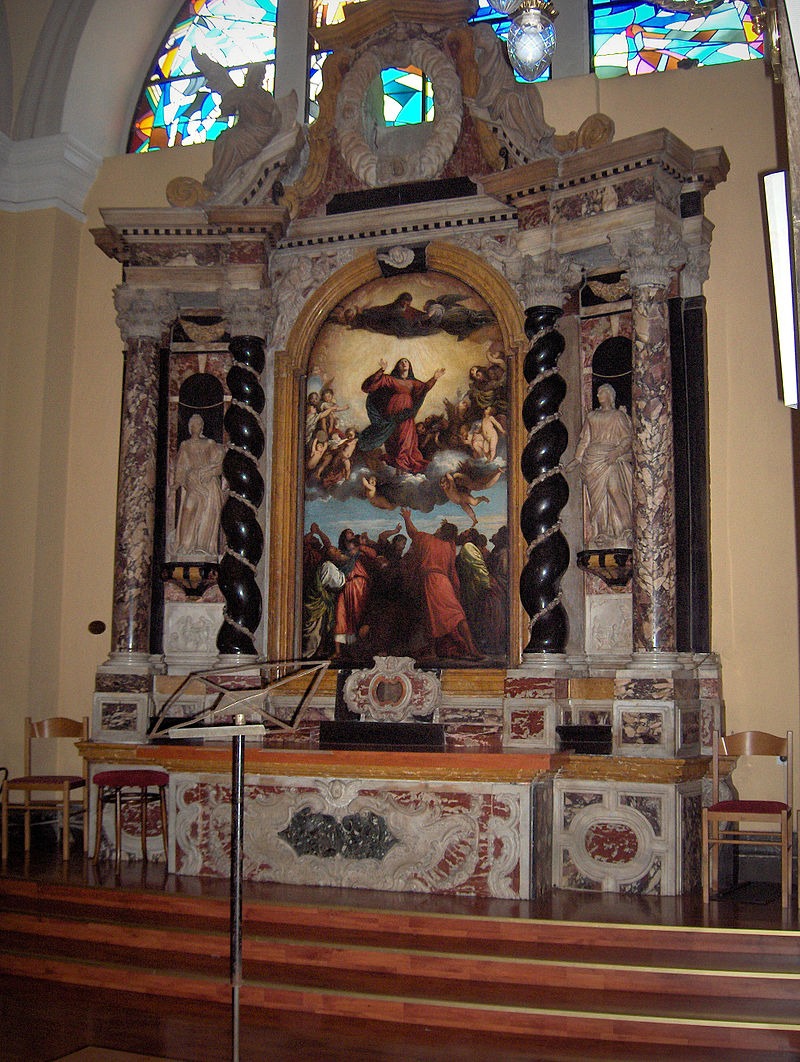
Choose one answer.
|
a.
The Venetian High Renaissance
began with Giorgione’s work.
|
||
|
b.
It can be argued that
Giorgione, like other Venetian
artists, focused more on color,
textural effects, and
representing the surface of
things, and focused less on
structure than artists in
Central Italy. |
||
|
c.
Among other things, he painted
mythological scenes and
pastorals. |
||
|
d.
He painted the “Assumption of
the Virgin,” pictured above.
|
||
|
e.
He was innovative and intuitive
in his painting techniques; he
liked to use canvas and he did
not make detailed preparatory
drawings. |
Question 61
Which of the following statements
accurately describes the “Lives of the
Artists”?
Choose one answer.
|
a.
Though this treatise retraces
the stylistic development of
many artists, it generally
gives no clue as to each artist
as a person and personality.
|
||
|
b.
This book was written by Vasari
in the sixteenth century.
|
||
|
c.
It was written to immortalize
and tell the lives of artists
and thus is a testimonial to
the changing status of the
artist and the individual.
|
||
|
d.
Both A and B |
||
|
e.
Both B and C |
Question 62
Which of the following statements
accurately describes the painting
below?
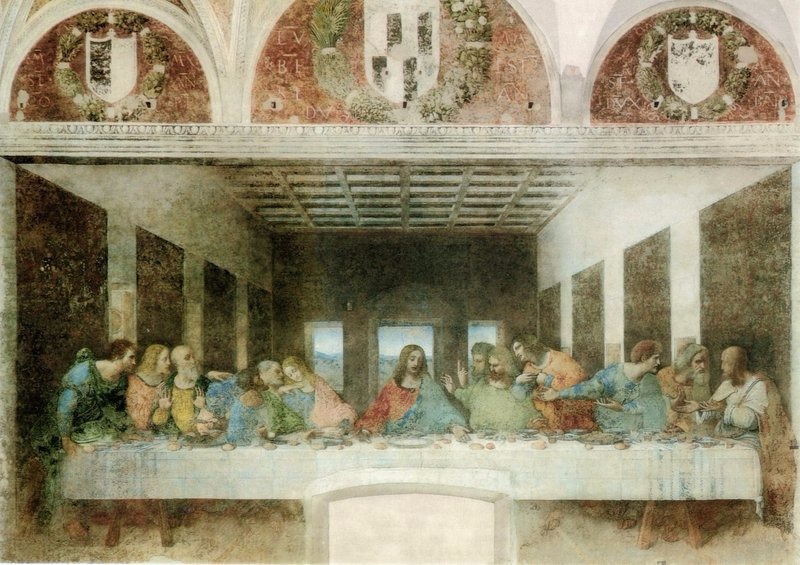
Choose one answer.
|
a.
It is an oil painting on canvas
by Raphael. |
||
|
b.
It depicts the “Last Supper”
with Christ in the center at
the vanishing point.
|
||
|
c.
In this painting, and as is
characteristic of High
Renaissance art, the focus on
depicting objects and
architecture realistically
tends to eclipse spiritual
symbolism to an afterthought.
|
||
|
d.
Judas is the figure to Christ’s
left, wearing green.
|
||
|
e.
It was painted for the Duke of
Milan’s palace. |
Question 63
Which of the following statements
accurately describes this sculpture of
Moses by Michelangelo?
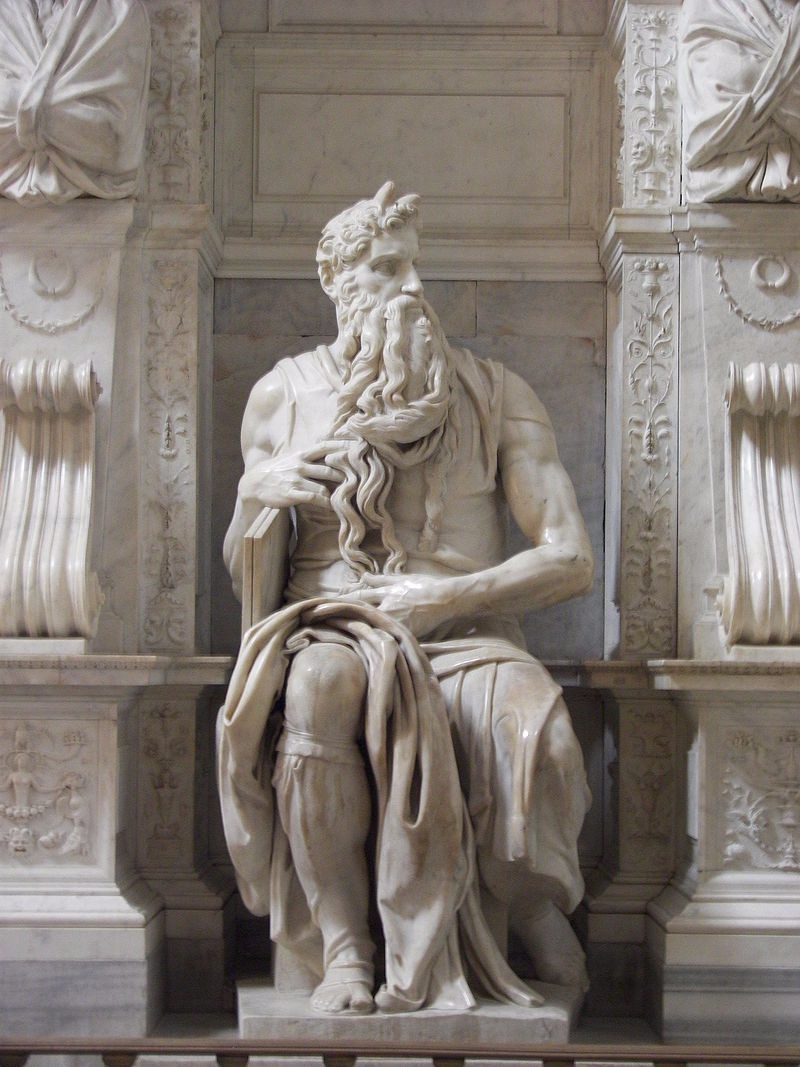
Choose one answer.
|
a.
It was to be part of Pope
Julius II’s tomb. |
||
|
b.
His transitional position (he
seems about to rise) can be
seen as characteristic of
Michelangelo’s art.
|
||
|
c.
His pronounced musculature can
be seen as characteristic of
Michelangelo’s style.
|
||
|
d.
The complex positioning of
Moses can be seen as
characteristic of High
Renaissance art. |
||
|
e.
All of the above |
Question 64
Which of the following statements
accurately describes the “School of Athens”
painted by Raphael?

Choose one answer.
|
a.
It was painted for the library
of Pope Julius II. |
||
|
b.
The two central figures are
Plato and Aristotle.
|
||
|
c.
It represents “poetry,” while
other frescos in the same room
represent other areas of human
knowledge (namely theology,
jurisprudence, and philosophy).
|
||
|
d.
Both A and B |
||
|
e.
Both A and C |
Question 65
Which of the following statements
accurately describes the “Disputa del
Sacramento” painted by Raphael?
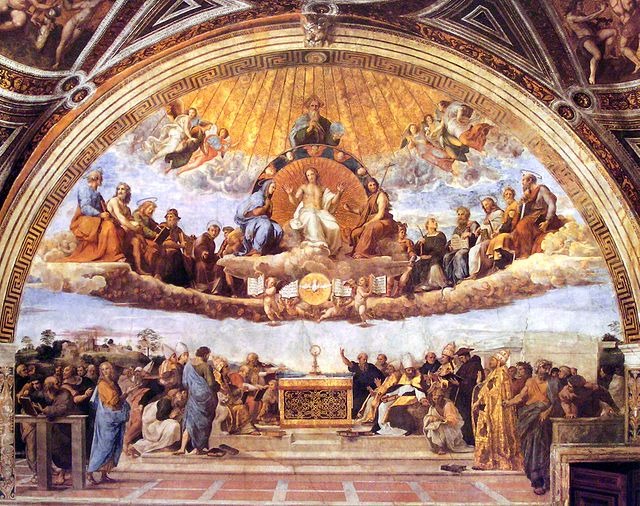
Choose one answer.
|
a.
It was painted for the library
of Pope Julius II and
represents theology.
|
||
|
b.
According to Robert Baldwin, it
reasserts the authority of the
pope. |
||
|
c.
C. According to Robert Balwin,
it justifies Catholic Church
dogma and sacraments as divine
in origin. |
||
|
d.
According to Robert Baldwin,
Raphael deliberately contrasted
figures of emotional lay people
against the calm and
knowledgeable figures of
theologians. |
||
|
e.
All of the above |
Question 66
Which of the following statements
accurately describes sixteenth-century
painters and painting in Venice and the
Veneto?
Choose one answer.
|
a.
Titian and Veronese, two
important forces for
sixteenth-century painting in
Venice, were known for their
striking use of color.
|
||
|
b.
Compared to Florentine
painting, Venetian painting was
known to emphasize the linear
aspect of figures and scenes
more. |
||
|
c.
Tintoretto, an important force
for sixteenth-century art in
Venice, was known for his very
tight, almost invisible
brushstroke. |
||
|
d.
Both A and B |
||
|
e.
Both B and C |
Question 67
Which of the following statements
accurately describes the work of the
architect Jacopo Sansovino?
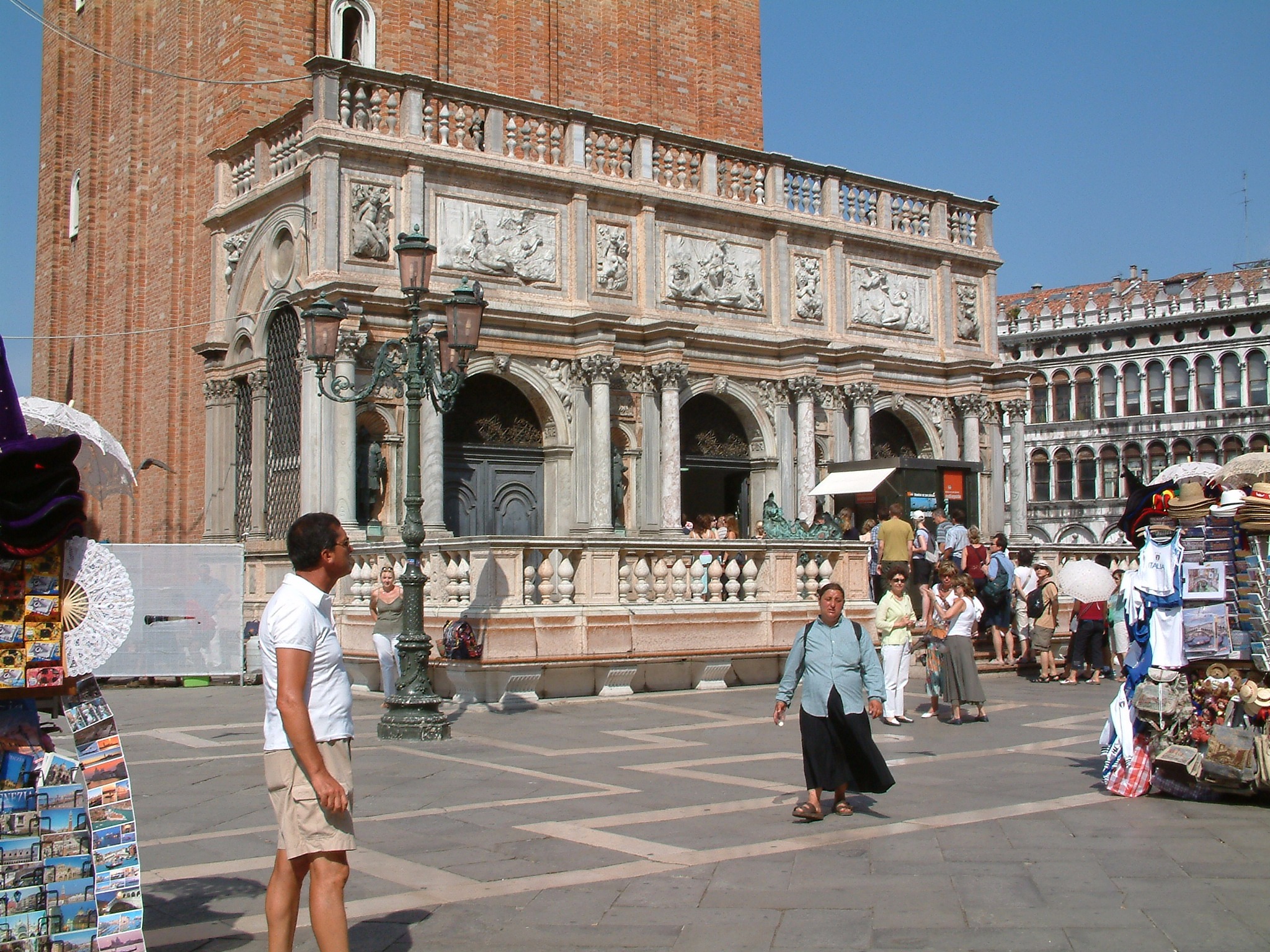
Choose one answer.
|
a.
He studied Roman and classical
architecture and incorporated
Roman/classical motifs into
Venetian architecture.
|
||
|
b.
He was popular in Venice
because of the desire to make
Venice a new Rome and dominate
the Mediterranean. |
||
|
c.
In his “Loggetta” pictured
above, stones from faraway
places were used to show and
suggest wealth. |
||
|
d.
All of the above |
||
|
e.
None of the above |
Question 68
Which of the following statements
accurately describes Michelangelo’s work on
the ceiling of the Sistine Chapel beside
St. Peter’s in Rome?
Choose one answer.
|
a.
The realization of the painting
of the ceiling was a great
challenge to Michelangelo,
because he considered himself
more of a sculptor, he had to
be on a scaffolding in an
uncomfortable position, and the
ceiling is curved. |
||
|
b.
The painting on the ceiling is
done in fresco. |
||
|
c.
The ceiling features many
biblical scenes separated by
illusionistic painted
stonework. |
||
|
d.
In the ceiling decoration, he
uses figures from classical
Antiquity, the Sybills.
|
||
|
e.
All of the above. |
Question 69
Which of the following statements best
describes how Renaissance artists studied
and illustrated the human anatomy?
Choose one answer.
|
a.
Pollaiuolo, Leonardo da Vinci,
Michelangelo, and other artists
performed anatomical
dissections and incorporated
their discoveries into the
representation of the human
figure. |
||
|
b.
Some artists printed studies of
the human body devoid of skin,
or the human skeleton and
developed anatomical
illustrations. |
||
|
c.
Leonardo da Vinci borrowed from
the architect to illustrate the
make-up of the human body by
representing human forms in
elevation, section, plan, and
perspectival view. |
||
|
d.
All of the above |
||
|
e.
None of the above |
Question 70
Which of the following statements best
describes the debate that took place
between artists and theorists who thought
“disegno” was the most important in
representing nature and those who thought
“colorito” was?
Choose one answer.
|
a.
While in Florence, color and
its ingenious application were
judged of prime importance to
render nature life-like,
Venetians thought that drawing
was the only indispensable
facet of an artwork that aimed
to render nature well.
|
||
|
b.
While in Venice, color and its
ingenious application were
judged of prime importance to
render nature life-like,
Florentines thought that
drawing was the most important
aspect of an artwork that could
render nature well.
|
||
|
c.
Vasari thought that color was
the foundation of art.
|
||
|
d.
Artists who thought color was
of more fundamental importance
usually made more preparatory
studies. |
||
|
e.
Artists who thought drawing was
of more fundamental experience
often painted directly on the
canvas, without preparatory
studies. |
Question 71
Who are some of the most important
protagonists of the High Renaissance in
Italy?
Choose one answer.
|
a.
Michelangelo, Leonardo da
Vinci, Raphael, and Bramante
|
||
|
b.
Masaccio, Fra Angelico,
Alberti, and Brunelleschi
|
||
|
c.
Giotto, Duccio, and Cimabue.
|
||
|
d.
Both A and B |
||
|
e.
Both B and C |
Question 72
Who created the painting below?
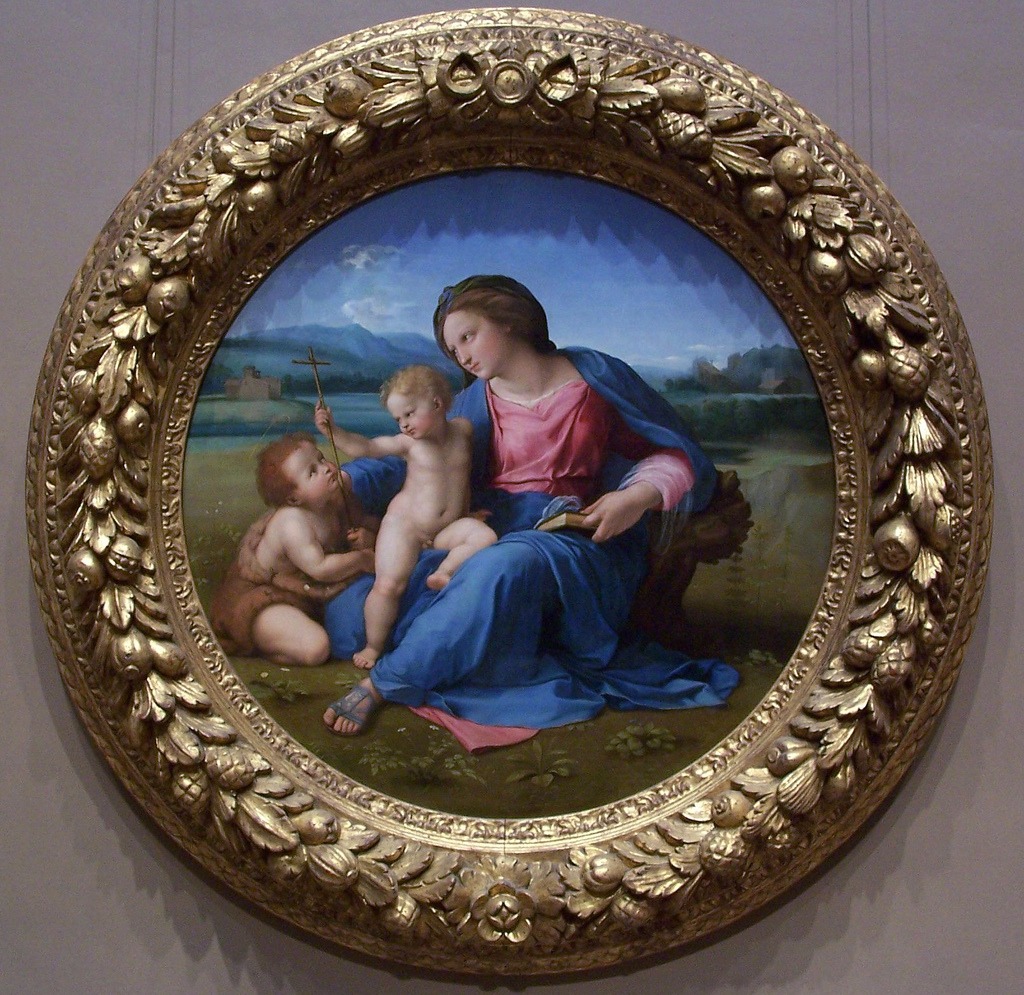
Choose one answer.
|
a.
Raphael |
||
|
b.
Michelangelo |
||
|
c.
Leonardo da Vinci |
||
|
d.
Titian |
||
|
e.
Veronese |
Question 73
Who was the first architect to work for
Julius II on St. Peter’s Church in Rome?
Choose one answer.
|
a.
Michelangelo |
||
|
b.
Bramante |
||
|
c.
Palladio |
||
|
d.
Alberti |
||
|
e.
Bernini |
Question 74
Who was Titian?

Choose one answer.
|
a.
One of the most important Roman
artists of the sixteenth
century. |
||
|
b.
A painter known, among other
things, for his use of color,
his painterly style, and his
poetic landscapes. |
||
|
c.
A painter who painted the
“Assumption of the Virgin”
above. |
||
|
d.
Both A and B |
||
|
e.
Both B and C |
Question 75
How did the Reformation and
Counter-Reformation define the role of art
in the Church?
Choose one answer.
|
a.
For the protagonists of the
Reformation, there was no place
for art in the Church.
|
||
|
b.
For the protagonists of the
Reformation, art in the church
could violate one of the ten
commandments that forbids
making idols of God.
|
||
|
c.
For the Counter-Reformation,
art in the Church was permitted
and valued but was not to be
worshipped itself. |
||
|
d.
All of the above |
||
|
e.
None of the above |
Question 76
According to Bernard Smith, how can
Leonardo da Vinci’s “Last Supper” be
compared with Tintoretto’s “Last Supper” of
1592?
Choose one answer.
|
a.
While Leonardo da Vinci’s “Last
Supper” is in the High
Renaissance style, Tintoretto’s
is Mannerist in style.
|
||
|
b.
Tintoretto’s painting is much
more nervous and dramatic than
Leonardo Da Vinci’s.
|
||
|
c.
Tintoretto’s scene is very
static when compared to
Leonardo da Vinci’s.
|
||
|
d.
Both A and B |
||
|
e.
Both B and C |
Question 77
According to Bernard Smith, what are the
characteristics of Michelangelo’s Pietà
that make it a good representative of High
Renaissance art by Heinrich Wöllflin’s
definition?
Choose one answer.
|
a.
Most of its compositional lines
point to places outside of
itself, opening it up to the
space surrounding it.
|
||
|
b.
It is very clear in design.
|
||
|
c.
The body of the Virgin and that
of Christ are not perceived as
separate entities. |
||
|
d.
Both A and B |
||
|
e.
Both B and C |
Question 78
According to Bernard Smith, which Venetian
architect was both a classicist and a
Mannerist architect?
Choose one answer.
|
a.
Bramante |
||
|
b.
Palladio |
||
|
c.
Sansovino |
||
|
d.
Brunelleschi |
||
|
e.
Alberti |
Question 79
According to Bernard Smith, who could be
considered the best representative of the
Mannerist style in Venice?
Choose one answer.
|
a.
Titian |
||
|
b.
Pontormo |
||
|
c.
Tintoretto |
||
|
d.
Bronzino |
||
|
e.
Rosso |
Question 80
All of the following statements accurately
describe the structure shown, EXCEPT:
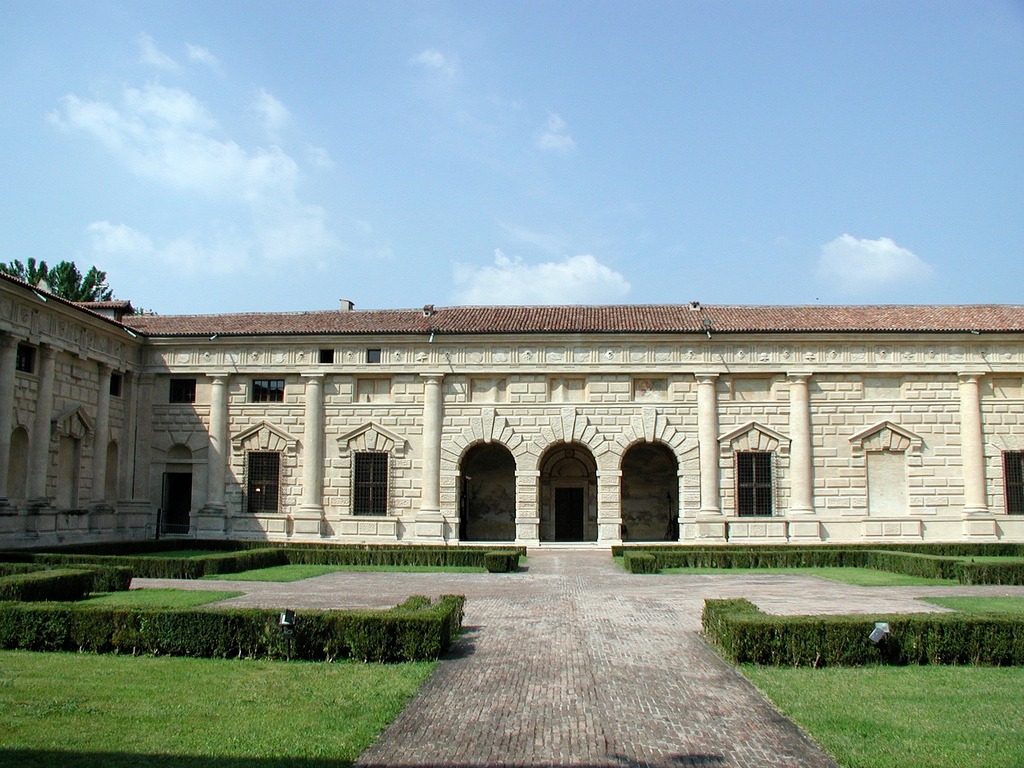
Choose one answer.
|
a.
It was conceived by Giulio
Romano. |
||
|
b.
It was built as a pleasure and
entertainment villa for the
Duke of Mantua. |
||
|
c.
It was built according to the
idea that form should follow
function. |
||
|
d.
It violates many classical
ideals; for example, the four
facades that can be seen from
the courtyard are all
different. |
||
|
e.
Compared to structures of the
High Renaissance, this
structure is not as unified and
symmetric. |
Question 81
All of the following statements accurately
describe the architecture shown,
EXCEPT:
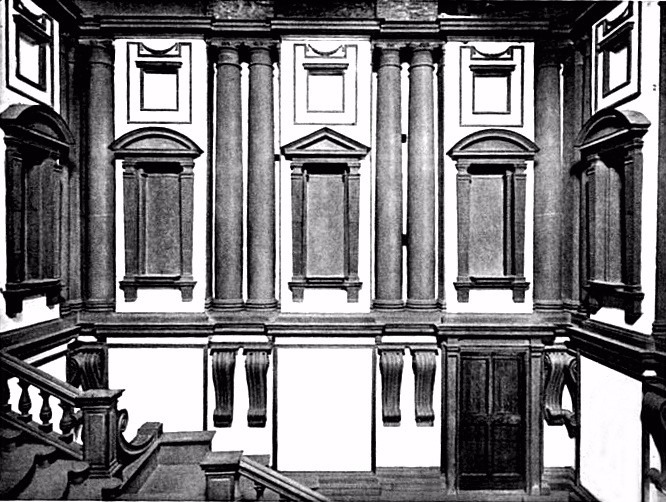
Choose one answer.
|
a.
It was designed by Giulio
Romano. |
||
|
b.
It is part of the Laurentian
Library in Florence.
|
||
|
c.
It was mostly conceived under a
Medici turned pope.
|
||
|
d.
It displays many architectural
elements, such as the volutes,
that confuse us as to their
potential supportive function.
|
||
|
e.
Its stairway does not feature
rails on its sides.
|
Question 82
During the early to mid-sixteenth century,
what role did the Medici fulfill?
Choose one answer.
|
a.
They were promoting Republican
ideals. |
||
|
b.
A Medici became pope in the
early sixteenth century.
|
||
|
c.
They wanted to create a very
sophisticated court.
|
||
|
d.
Both A and B |
||
|
e.
Both B and C |
Question 83
Fill in the blanks. The portrait shown
below was made in the ________________
century, in the _________________
style.
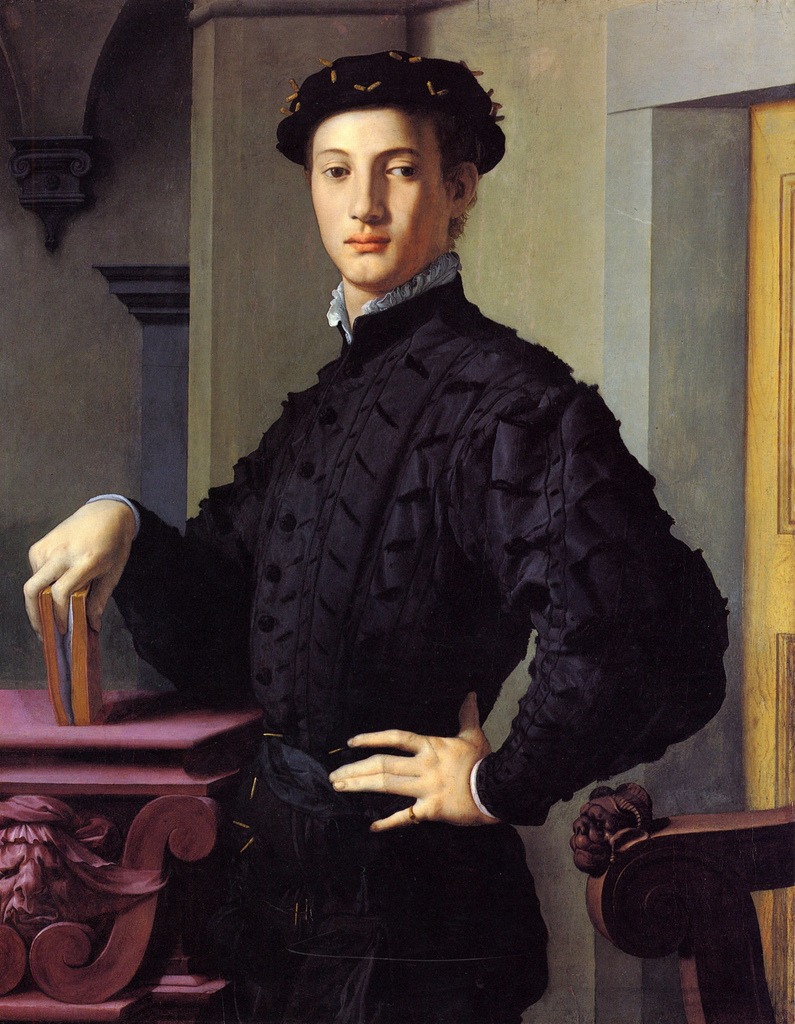
Choose one answer.
|
a.
Thirteenth, High Renaissance
|
||
|
b.
Fifteenth, Mannerist
|
||
|
c.
Fifteenth, High Renaissance
|
||
|
d.
Sixteenth, High Renaissance
|
||
|
e.
Sixteenth, Mannerist
|
Question 84
How does Giulio Romano’s interior
decoration in the Pallazo del Te interact
with the exterior treatment of the same
palace?
Choose one answer.
|
a.
Giulio Romano made frescos that
display illusionistic
architecture. |
||
|
b.
In the so-called “Hall of
Giants,” the dominating
depiction of dismantled
architecture gives one the
sense that the Palazzo del Te
is falling. |
||
|
c.
Though the exterior facades
confuse the viewer by their
unconventional use of classical
elements, the interior can be
considered a “refuge” in its
ordered and serene painted
compositions. |
||
|
d.
Both A and B |
||
|
e.
Both C and D |
Question 85
The sixteenth century in Italy was marked
by which of the following?
Choose one answer.
|
a.
Invasions by foreign entities
|
||
|
b.
The bloody “Sack of Rome”
|
||
|
c.
Disease |
||
|
d.
All of the above |
||
|
e.
None of the above |
Question 86
What makes the sculpture, shown below, a
mannerist sculpture?
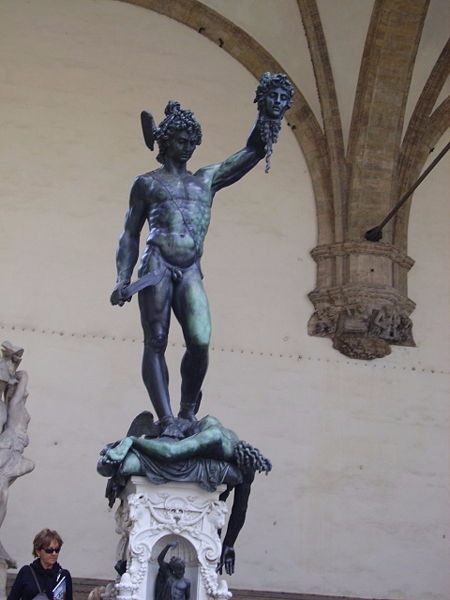
Choose one answer.
|
a.
It downplays the artist’s
skill. |
||
|
b.
It can be seen in the context
of an erudite and intellectual
game of cross-referencing in
which Michangelo’s neighboring
“David” and by extension the
Republic of Florence are
conquered. |
||
|
c.
It makes no reference to
classical antiquity.
|
||
|
d.
All of the above |
||
|
e.
None of the above |
Question 87
Which artist made the sculpture
below?
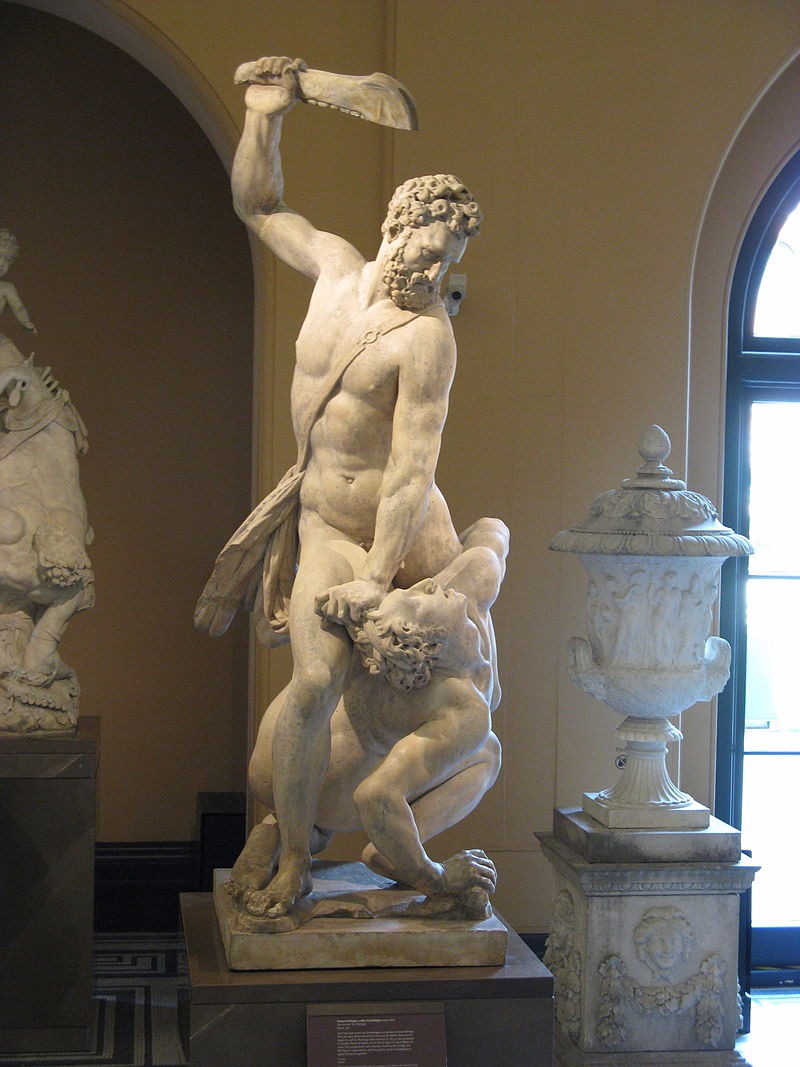
Choose one answer.
|
a.
Nanni di Banco |
||
|
b.
Giambologna |
||
|
c.
Donatello |
||
|
d.
Michelangelo |
||
|
e.
Bronzino |
Question 88
Which characteristics of High Renaissance
art did Mannerism turn away from?
Choose one answer.
|
a.
The focus on technical
virtuosity |
||
|
b.
Naturalism and rational
compositions |
||
|
c.
Elegant lines and figures
|
||
|
d.
Both A and B |
||
|
e.
Both B and C |
Question 89
Which of the following accurately describes
Mannerist architects and architecture?
Choose one answer.
|
a.
Mannerist architecture creates
a sense of confusion as to the
function of the architectural
devices it uses or displays.
|
||
|
b.
Mannerist architects tried to
eradicate any reference to
classical prototypes in their
designs. |
||
|
c.
Bramante’s Tempietto is a
Mannerist structure.
|
||
|
d.
All of the above |
||
|
e.
None of the above |
Question 90
Which of the following artworks by a High
Renaissance artist can be considered to
make the transition into Mannerism?
Choose one answer.
|
a.
Raphael’s “The School of
Athens” |
||
|
b.
Raphael’s “The Alba Madonna”
|
||
|
c.
Michelangelo’s “The Last
Judgment” |
||
|
d.
Both A and B |
||
|
e.
Both B and C |
Question 91
Which of the following can be considered
characteristic of mannerist portraiture?
Choose one answer.
|
a.
A focus on the sitter’s
personality and psychology
|
||
|
b.
A focus on the sitter’s status
and sophistication |
||
|
c.
Dynamism: the sitter is often
captured in motion |
||
|
d.
All of the above |
||
|
e.
None of the above |
Question 92
Which of the following can be considered
common characteristics of Mannerist
paintings?
Choose one answer.
|
a.
Elegance |
||
|
b.
Focus on artificiality
|
||
|
c.
Appeal to all segments of
society |
||
|
d.
Both A and B |
||
|
e.
Both B and C |
Question 93
Which of the following statements
accurately characterizes Benvenutto
Cellini?
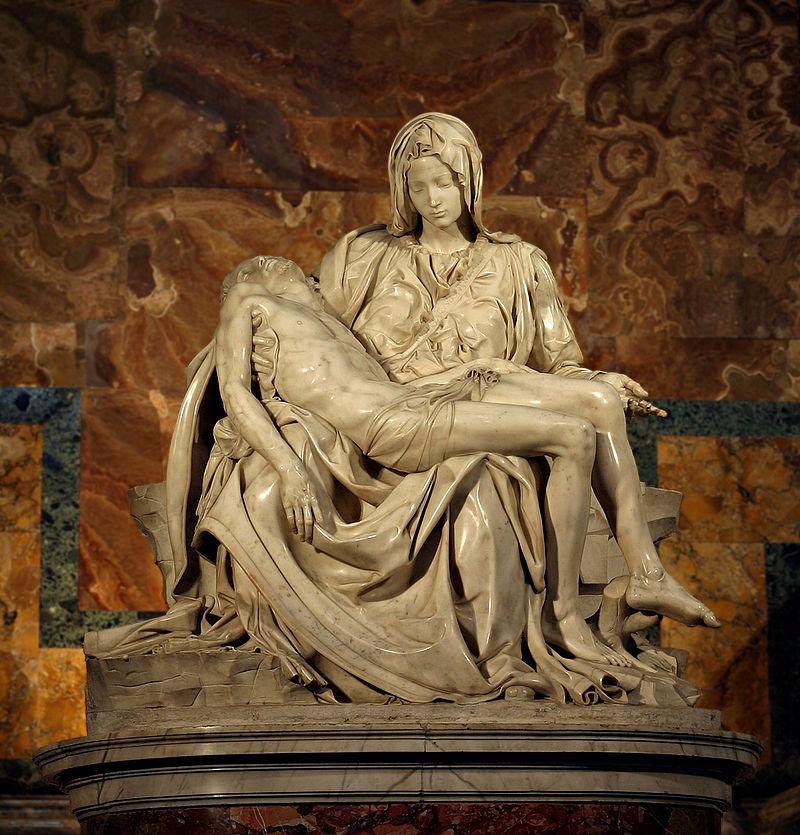
Choose one answer.
|
a.
He wrote an autobiography in
which he gave an exhaustive
picture of the historical
circumstances of his time, such
as the Sack of Rome or the
religious battles. |
||
|
b.
He wrote an autobiography in
which he detailed the artistic
world of his times and depicted
his life as full of adventure
and great accomplishments.
|
||
|
c.
He created the sculpture shown
above. |
||
|
d.
Both A and C |
||
|
e.
Both B and C |
Question 94
Which of the following statements
accurately characterizes the painting
below?
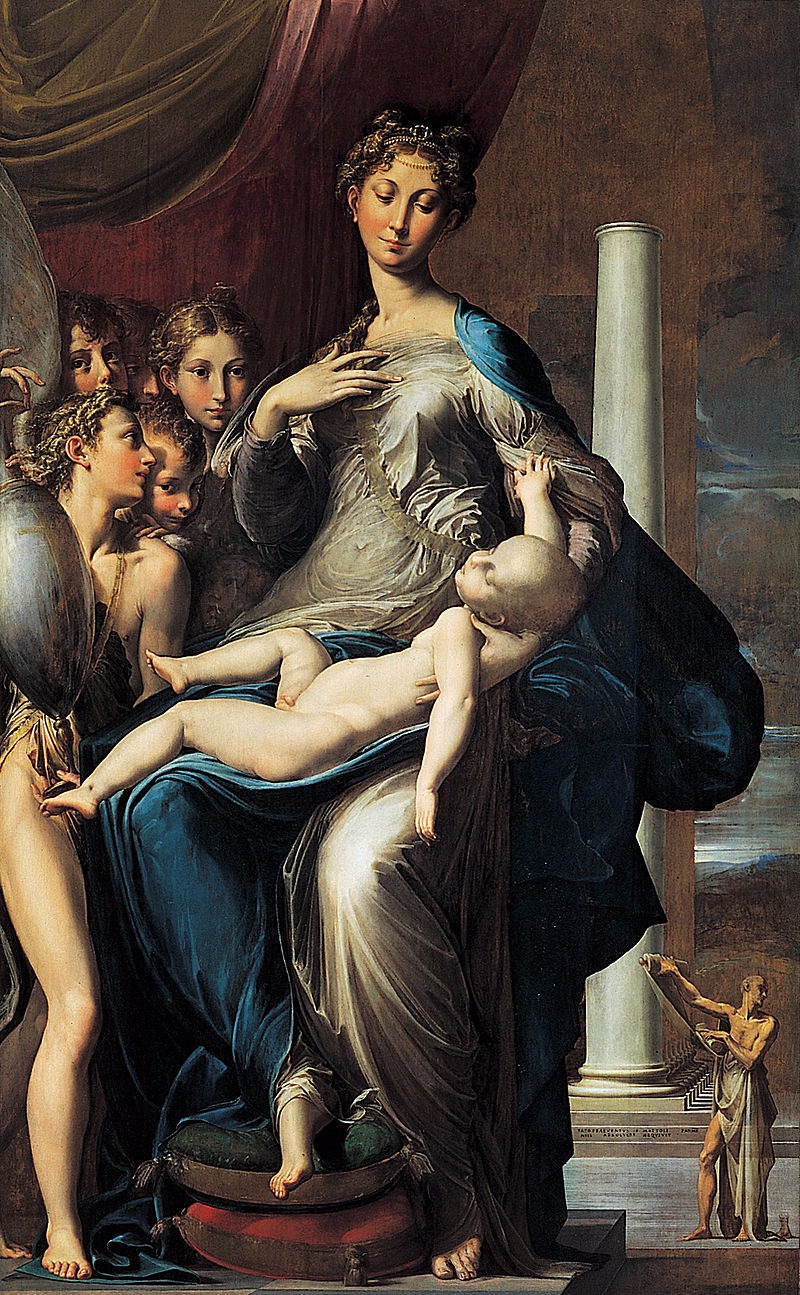
Choose one answer.
|
a.
It is typically mannerist
because of its “S” or
serpentine compositional lines.
|
||
|
b.
It is typically mannerist
because of its irrational and
unnatural sense of scale and
proportion. |
||
|
c.
It is typically mannerist,
because Christ’s inevitable
death seems to be implied
through the figure of the
Christ Child. |
||
|
d.
Both A and B |
||
|
e.
Both B and C |
Question 95
Which of the following statements
accurately describes the sculpture
below?

Choose one answer.
|
a.
It is a bronze cast by
Benvenutto Cellini for a Medici
duke. |
||
|
b.
The dramatic passed-down story
of this sculpture’s casting
emphasized the amazing skill of
Cellini, who overcame the many
difficulties of casting such a
complex figure. |
||
|
c.
It represents Perseus, a figure
taken from classical mythology.
|
||
|
d.
All of the above |
||
|
e.
None of the above |
Question 96
Which of the following statements is true
of Giambologna?
Choose one answer.
|
a.
He was influenced by
Michelangelo. |
||
|
b.
His bronze sculptures were
sometimes used as diplomatic
gifts by the Medici.
|
||
|
c.
He made exclusively monumental,
large-scale sculptures.
|
||
|
d.
Both A and B |
||
|
e.
Both B and C |
Question 97
Who created the painting below?
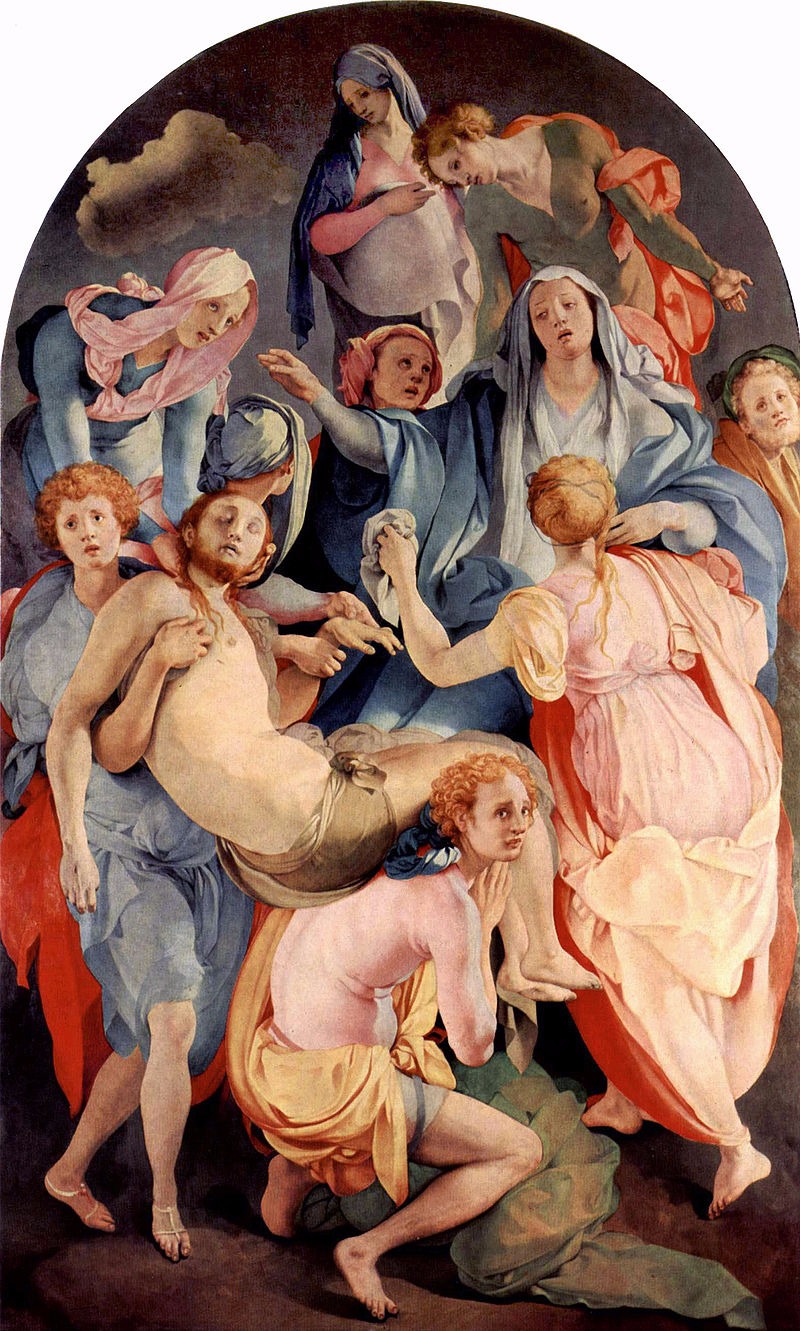
Choose one answer.
|
a.
Pontormo |
||
|
b.
Michelangelo |
||
|
c.
Rosso Fiorentino |
||
|
d.
Parmigianino |
||
|
e.
Raphael |
Question 98
Who was dismayed by what he saw in Rome and
the Church in the sixteenth century, such
as indulgences, and would go on to become
the first leading figure of the
Reformation?
Choose one answer.
|
a.
Martin Luther |
||
|
b.
John Calvin |
||
|
c.
St. Francis of Assisi
|
||
|
d.
Cosimo da Medici |
||
|
e.
John Knox |
Question 99
Why are Giovanni da Bologna’s sculptures
significant in the history of art?
Choose one answer.
|
a.
Because he made sculptures that
were not meant to be seen from
one point of view, rather his
sculptures were intended for a
viewer in motion. |
||
|
b.
He made sculptures using the
lost-wax technique.
|
||
|
c.
Because for the first time
since Antiquity, he sculpted
monumental nude figures.
|
||
|
d.
All of the above |
||
|
e.
None of the above |
Question 100
According to Peter Levine, which of the
following statements would describe
mannerism well?
Choose one answer.
|
a.
Mannerist artists were
concerned with the issue of
style in an artwork.
|
||
|
b.
Mannerist artists were
concerned with their own
subjectivity and originality.
|
||
|
c.
The development of mannerism
was a way to create interest in
a very stable and peaceful
society. |
||
|
d.
Both A and B |
||
|
e.
Both B and C |